Best Small Sailboats for Beginners
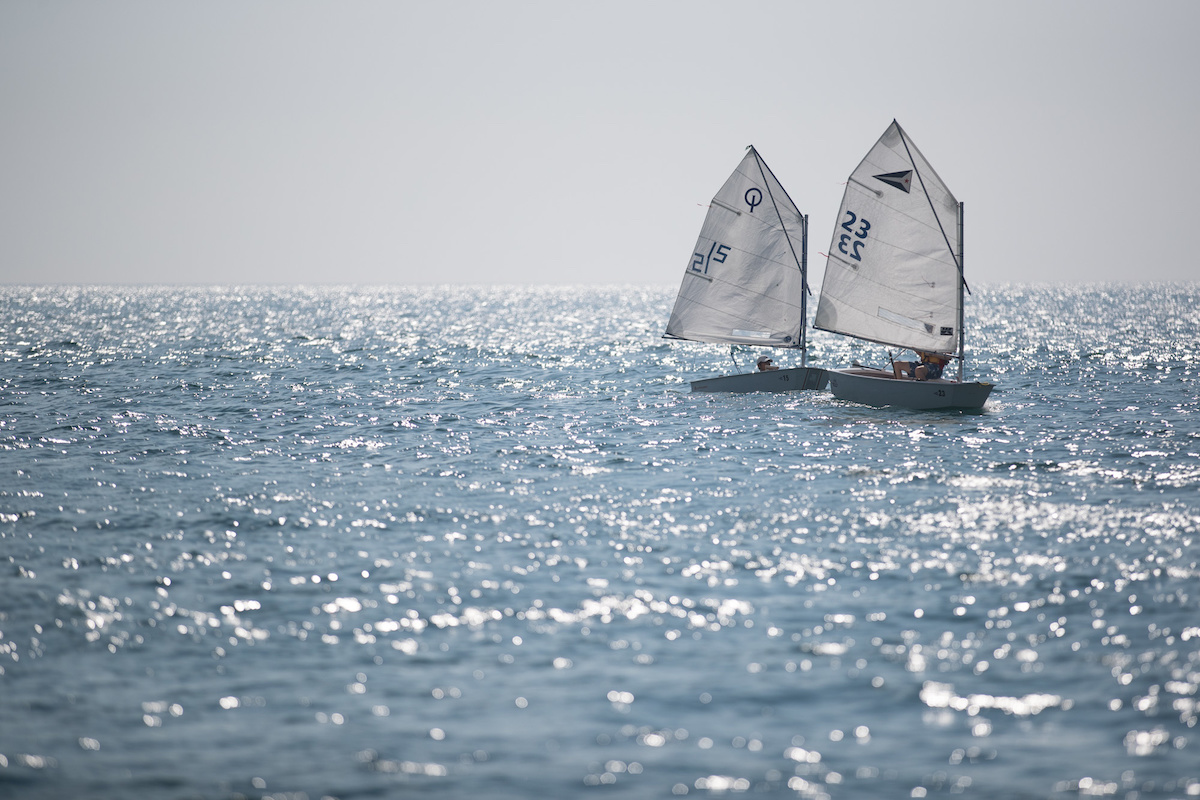
There are a number of classic trainers used by yacht club youth programs as well as techie new designs. Without mentioning specific models and brands, it’s difficult to outline which small boats are best but here are things to look for in good teaching boats.
Some of the best small sailboats for beginners include:
- Boats with tillers steering
- Boats with no winches
- Sailing dinghies
- Small sloops
- Small catamarans
- Rotomolded boats
- Trailerable sailboats
Explore All Sailboat Types

Boats with Tiller Steering
Steering by tiller (rather than a wheel) can make a difference when learning. Tillers are directly connected to the rudder that manages the boat’s direction. Tillers provide quick feedback about the strength and direction of the wind as well as the boat’s turning agility at various speeds.
Boats with No Winches
Boats that require no winches to manage the sheets and halyards are best for youngsters and new sailors. These boats usually don’t experience the same forces on the sails and rigging as larger boats, which can be a handful when the wind starts to blow. Winches are usually replaced with cam or jam cleats, which are easy to use.
Sailing Dinghies
Sailing dinghies are usually rigged with one mast and one sail and offer kids and new sailors simplicity so it’s easy to learn the ropes. Less overwhelming than boats with two sails, dinghies are light and responsive. They also have a shallow draft due to side or centerboards so they can be sailed just about anywhere. In some cases (whether from a wind gust or sudden crew weight shift) sailing dinghies can capsize so students should wear lifejackets and know how to swim. Sailing dinghies are usually sailed by one or two people.
Small Sloops
Small sloops with a mast that carries head and mainsails are the next step so students learn how sails work together. Headsails can be hanked on or attached to a small roller furler. These boats may have some or no winches, which also makes them easier to maintain. These boats can usually be sailed with one to four people.
Some sloops can scale up, providing a more challenging experience for sailors as they develop skills. Certain models can carry spinnakers and larger headsails to teach sail combinations and new sail trim techniques. Others offer the ability to hike out (shift crew weight well outboard to balance the boat against the wind pressure in the sails). This kind of sailing is more advanced.
Small Catamarans
Small catamarans provide extra stability for those who may be nervous about capsizing or aren’t fond of heeling (tipping while sailing). With two hulls providing a wide and stable base, catamarans area ideal for beginners, which may be why they’re often used by resorts as their beach sailing tourist boats. Rigged with one or two sails, small cats are tiller steered and usually have a trampoline that the students sit on and sail.
Rotomolded Boats
Small rotomolded boats are very forgiving due to their durable construction. Unlike fiberglass or wooden boats, rotomolded (a type of plastic construction technique) trainers can bounce off docks or other boats and cause or sustain little damage. Dinghies and catamarans can both be made via rotomolding.
Trailerable Sailboats
Finally, small sailboats that can be trailered to different locations add variety and that makes learning fun. Students can learn to sail in different wind and water conditions and enjoy their boats differently on vacation or with new friends.
Learning to sail involves all the senses and requires a level head and lots of practice and although it can be learned in many ways, the best way is to start with a boat that’s small, simple, safe and durable.
Read Next: Small Boats: What Are My Options?
You Might Also Like:
- Sailing Basics: 10 Nautical & Sailing Terms to Know
- Learning the Basics of Sailing
- Why Sailing?
- Find the Right Boat for Your Lifestyle
- Explore Sailboat Brands
Join Our Newsletter!
Get community news, buying bargains, and how-to guides at your fingertips.
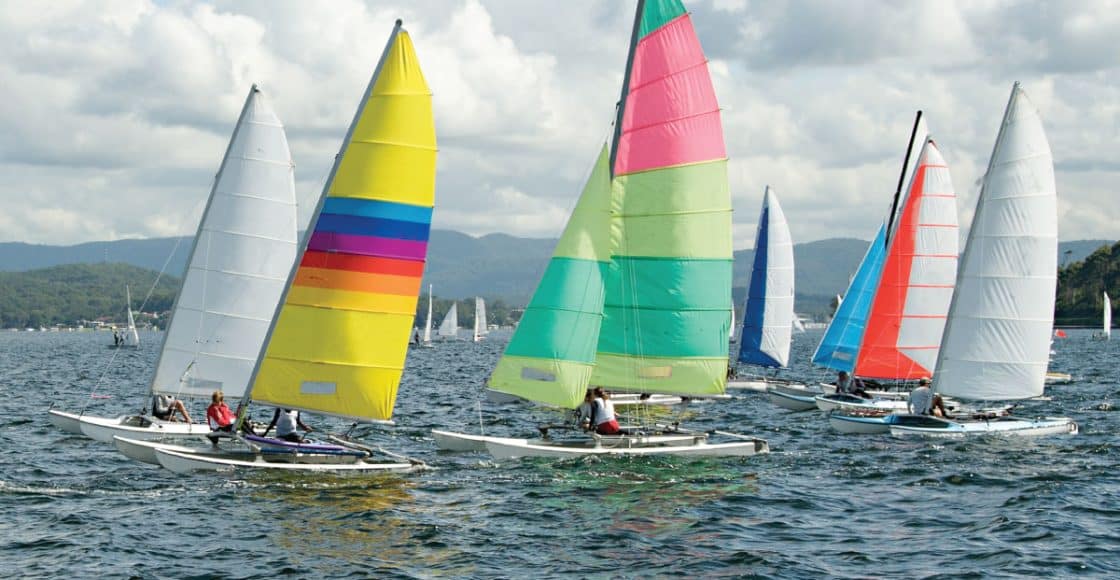
10 Best Beginner Sailboats
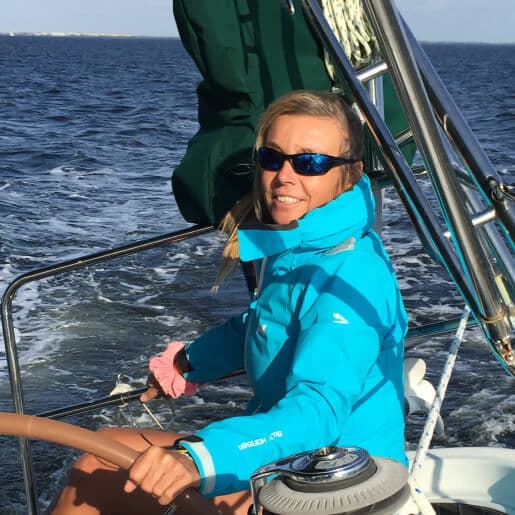
Table of Contents
Last Updated on August 17, 2023 by Boatsetter Team
While it’s possible to start sailing on any size and complexity of boat, you might want to read through to get to know the best beginner sailboats . You may have heard the tales of well-to-do sailors buying 50-footers as their first boat. It’s not unheard of to start big, but it’s not advisable.
Discover sailboats for rent near you— Only at Boatsetter
Learning to sail on a small boat rather than on a large one does two things: it immediately shows you the effect of every adjustment to sail trim and boat direction that you make, and it teaches you to be aware of the wind– where it’s coming from and how it’s shifting.
You want to start sailing on boats 12-25 feet with a tiller. Sloop-rigged (meaning having one mast and two sails) boats are simple to learn and control, which is why they’re used in many sailing schools, as are cat-rigged boats with just a mainsail.
Key Characteristics of a Beginner Sailboat
A small and agile boat will help you quickly learn what to do and not do. Look for a boat that’s responsive but not twitchy and unpredictable.
A small and lightweight boat can get you in trouble in gusts. Look for a stable craft with a low center of gravity that forgives mistakes. Small catamarans like Hobie cats or the inflatable MiniCat or wide, flat-bottomed boat should help.
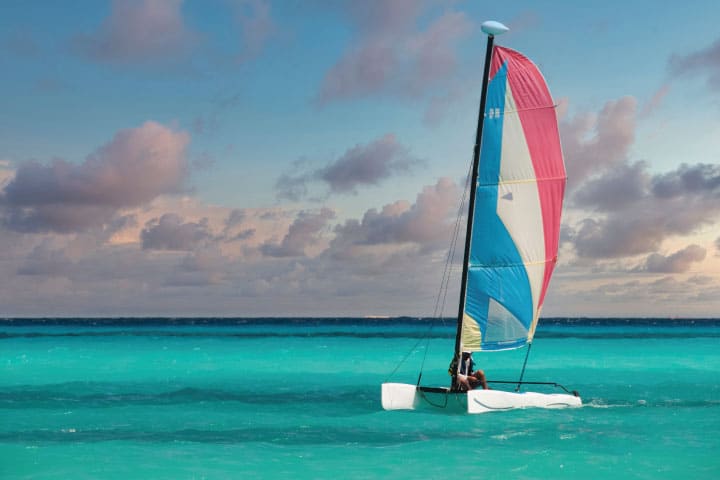
When learning to sail, focus on the basics of sail trim and shape. The boat needs just a few mechanical adjustments to eke out the best speed. Cams or cleats often replace winches for simple line management.
When learning to sail, you’ll make mistakes, including bumping into docks or grounding in shallows. Choose a boat that can take it. Rotomolded and tough fiberglass boats can take a beating and keep on sailing.
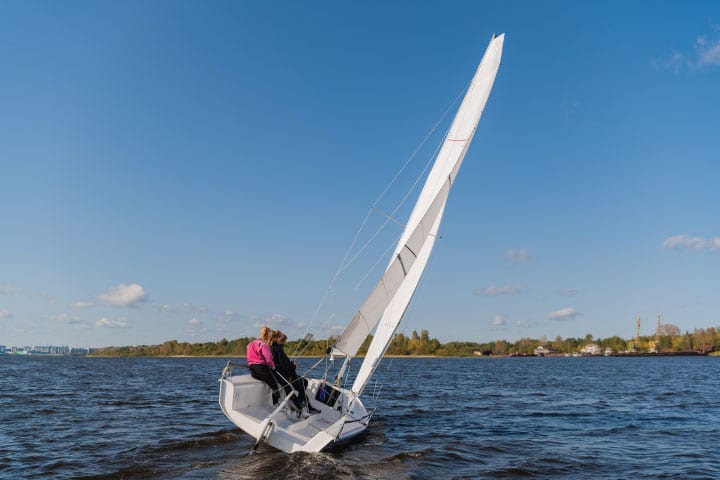
Trailerable
Small sailboats you can trailer will let you practice sailing on different bodies of water, giving you various experiences. Also, keeping a boat on a trailer rather than in a slip will save you money.
Some boats, rigged simply to teach the basics, can step up later to carry larger downwind sails like spinnakers to help you perfect your craft.
Don’t rush out to buy the best and newest. Practice with a used boat, preferably 5-15 years old, which is old enough to not worry about dings and new enough to not need constant care.
One sure way to learn the ropes is by joining Boatsetter Academy at any one of its 16 locations. Through this 2-hour, hands-on, boating course, beginners like you will build confidence and become familiar with the basics of boating. And the best part: it’s completely free!
READ MORE: Do Sailboats Have Motors?
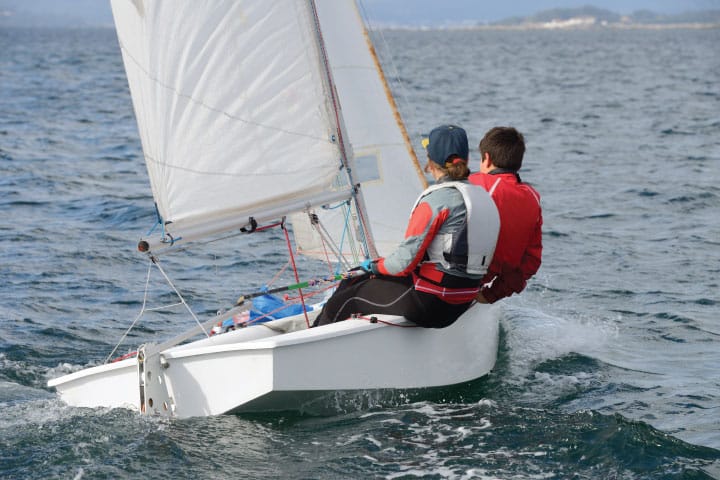
While there are lots of boats that meet the criteria above, here is our list of ten of the best sailboats for novice boaters :
- Laser – used for teaching youth programs and yacht club racing
- Sabot – a single-sail dinghy that’s great for kids
- Optimist – dinghy often used for single-handed sailing
- Lido – an old design but still easy to find and quite durable
- Capri – only 8 feet, these used to be staples in resort sailing fleets
- Sunfish – with a single sail and a centerboard, nothing could be simpler
- Catalina 22 and 27 – large cockpits have a safe feeling, and the boats are basically indestructible
- Hunter 22 – an oldie but a goody, you can still find these models with private owners
- Hobie cat – rotomolded, tough, and fast, these catamarans are great fun
- MiniCat – inflatable sailboat with surprising versatility and lots of advanced adjustments for when you’re ready to step up
Once you’ve mastered the basics, you can try a variety of sailboats by renting from a peer-to-peer (P2P) service like Boatsetter . With enough practice, you’ll be on that 50-footer, sailing like a pro.
Check out the hottest boats in the market at Boat Types , and make sure to scroll through Boat Guides to find your next boating destination .
Boatsetter is a unique boat-sharing platform that gives everyone— whether you own a boat or you’re just renting — the chance to experience life on the water. You can list a boat , book a boat , or make money as a captain .
Rent, Charter, Share— Only at Boatsetter

Zuzana Prochazka is an award-winning freelance journalist and photographer with regular contributions to more than a dozen sailing and powerboating magazines and online publications including Southern Boating, SEA, Latitudes & Attitudes and SAIL. She is SAIL magazines Charter Editor and the Executive Director of Boating Writers International. Zuzana serves as judge for SAIL’s Best Boats awards and for Europe’s Best of Boats in Berlin.
A USCG 100 Ton Master, Zuzana founded and manages a flotilla charter organization called Zescapes that takes guests adventure sailing at destinations worldwide.
Zuzana has lived in Europe, Africa and the United States and has traveled extensively in South America, the islands of the South Pacific and Mexico.
Browse by experience
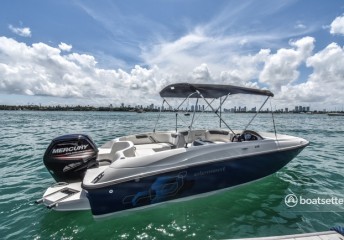
Explore articles
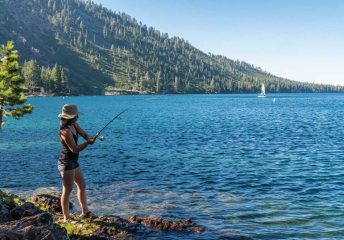
Fishing in Lake Tahoe Guide
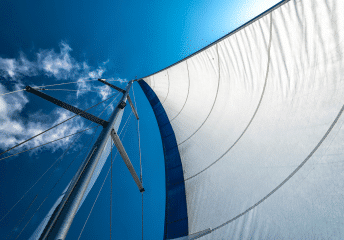
Type Of Sails: A Complete Guide

6 Best Lakes in Wisconsin for Boating
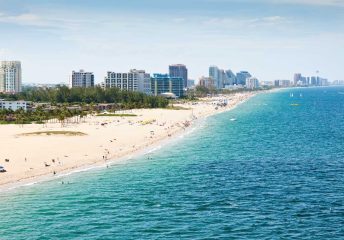
Top 5 Florida East Coast Beaches
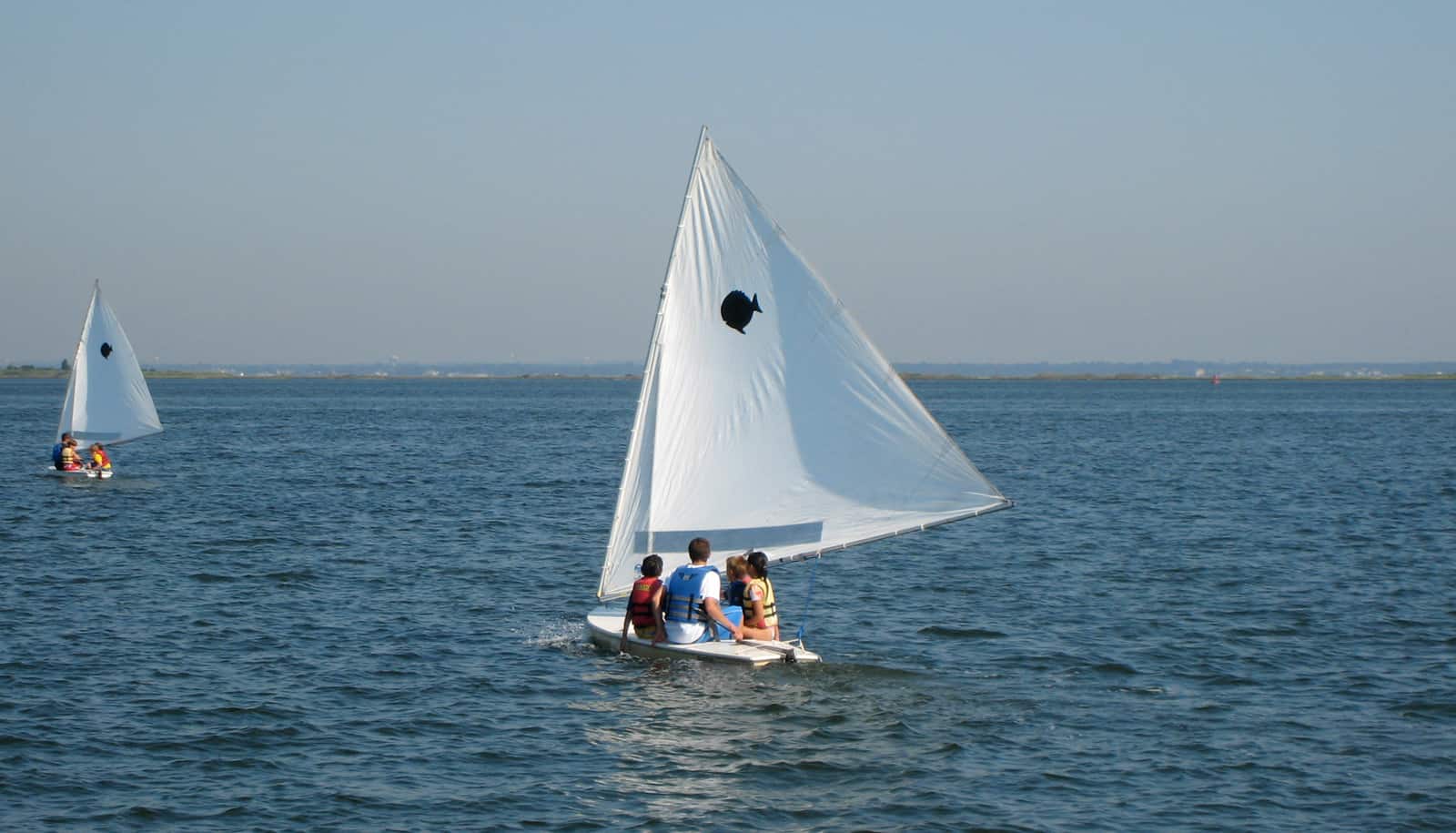
Best Small Sailboats for Beginners: Discover My Three Favorites and Set Sail with Confidence
Sailing is a fun and enjoyable activity for everyone, no matter the experience level.
Mastering how to sail a primary boat is effortless. I encourage beginners to practice in the right environment as they can gain considerable experience with time.
Since most beginners make the mistake of picking the wrong boat to start with, they get frustrated and quit before they can sail by themselves.
In this blog, I will cover the best small sailboats for beginners to help mitigate this problem.
Read on to learn more…
- Catalina 16.5
So, What’s the Best Small Sailing Boat For Beginners?
The three best small sailboats for beginners.
Sunfish is a personalized boat for beginners to sail with. Its ease of use makes sailing enjoyable for both beginners and experienced sailors.
Key Specifications
- Sail Area: 75 Square Feet
- Hull Weight: 120 Pounds
- Capacity: 1-2 people
- Optimal Weight: up to 190 pounds
Key Features
- Sunfish has a patented kick-up rudder that makes beach launches, landings, and shallow-water sailing effortless.
- It has a self-bailing cockpit.
- It has a stainless steel bow handle that enables carrying, docking, and holding the boat into the wind while launching or loading.
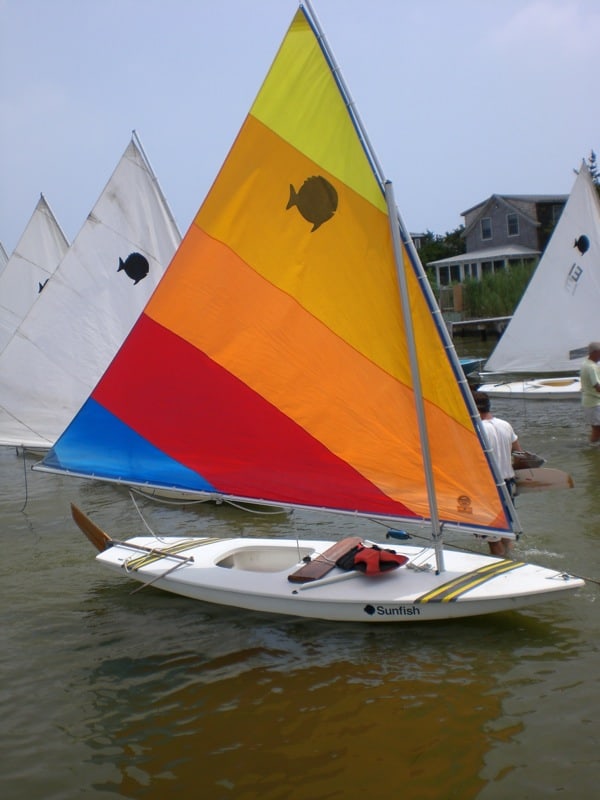
- Easy to sail and rig using a single control line
- Fast planning sailboat in good wind
- It is cheap
- Daggerboard and kick-up rudder enable easy beaching.
- Little freeboard and small cockpit
- A beginner can easily capsize
Why I Have Included Sunfish Sailboat in My List
I have included this sailboat in my list because it combines performance, durability, and stability suitable for beginners and experts.
With this boat, you can quickly learn how to sail, and you can’t go wrong with it.
More Info International Sunfish Class Association
Hunter 15 is a safe and versatile boat for both beginners and masters in sailing.
- Passenger capacity: 4
- Length overall: 4.4 m (14′6″)
- Draft – Board Up: (6″)0.15 m
- Draft – Board Down: (3’0″)0.92 m
- Material: fiberglass
- Appendages: lifting keel
- Intended use: daysailer
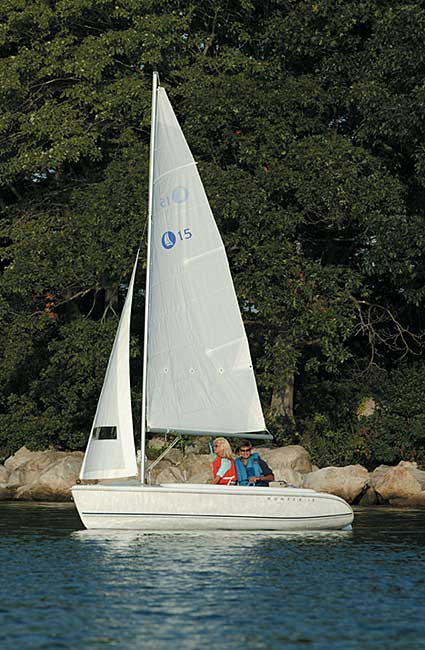
- Stainless steel arch
- Spacious cockpit area
- Easy to balance
- It doesn’t sail well in downwind
- No separate starting battery
Why I Have Included the Hunter 15 Sailboat in My List
I have included this boat in my list because it has a comfortable wide beam, a contoured self-bailing cockpit and fiberglass construction.
Additionally, it is designed to allow beginners to sail around with ease, and it is a safe boat giving sailors a confident feeling and peace of mind as they sail.
More Info marlow-hunter.com
Catalina 16.5 is a small, powerful recreational sailing boat constructed predominantly of fiberglass.
- LOA: 16.33 ft. / 4.98 m
- Approximate Base Wt.: 430lb.
- Draft Board up: 5″
- Draft Board down: 4’5″
- Fiberglass composite Kick-up rudder
- Stainless steel standing rigging
- Adjustable hiking straps
- Self-bailing cockpit
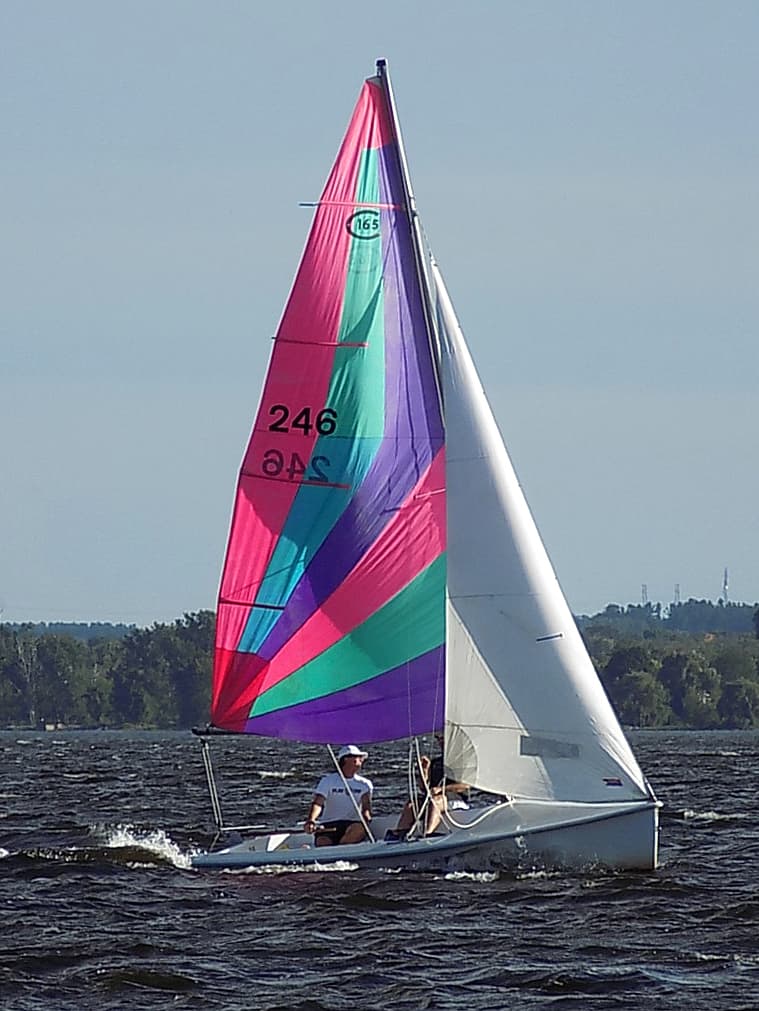
- Fast sailboat
- Easy to sail and rig around
- Difficult to balance
Why I Have Included Catalina 16.5 Sailboat in My List
I have included Catalina 16.5 boat in the list because of its fantastic design, is versatile, and you can get them in two designs: the keel model and the centreboard model.
More Info www.catalinayachts.com
Here are my top three picks of best small sailboat for beginners :
If I had to pick one, I would go for Hunter 15 sailboat because it has the the best safety features. The Hunter 15 sailboat is also easy to operate, plus you can dock with no problem. The boat is easy to maintain, and it’s not complicated for a beginner.
What is your choice?
Disclaimers
All product names, logos, and brands are property of their respective owners. All company, product and service names used in this website are for identification purposes only. Use of these names, logos, and brands does not imply endorsement.
It is our policy to make every effort to respect the copyrights of outside parties. If you believe that your copyright has been misused, please provide us with a message stating your position and we will endeavor to correct any misuse immediately.
Some of the links in this post are affiliate links. As an Amazon Associate, we earn from qualifying purchases. This means if you click on the link and purchase the item, we may receive an affiliate commission, at no extra cost to you. This helps us keep this website alive. Learn more here .

Hi, I’m Igor, Skipper of S/Y "The Hooker". A decade ago, I conquered my childhood dream: to be a sailing skipper, own a sailing yacht. Yes, it knocked dullness out of my urban life — Read more →
Leave a Reply Cancel Reply
Your email address will not be published. Required fields are marked *
Name *
Email *
Add Comment *
Save my name, email, and website in this browser for the next time I comment.
Post Comment
Related Posts
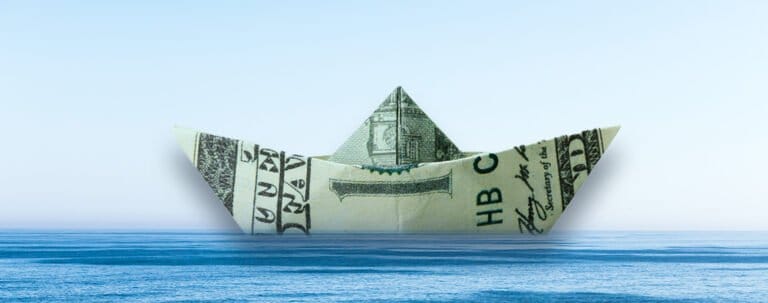
Buying a Boat? Check Your Credit Score
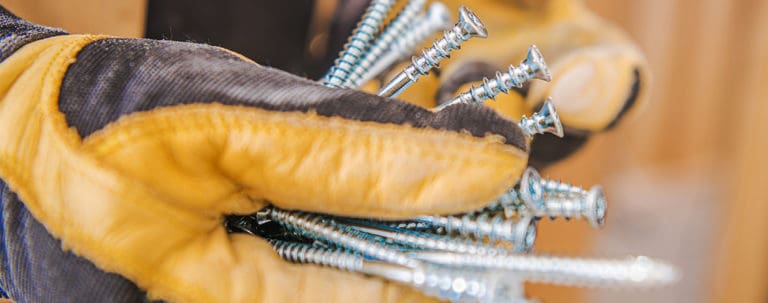
Best Screws for Fiberglass
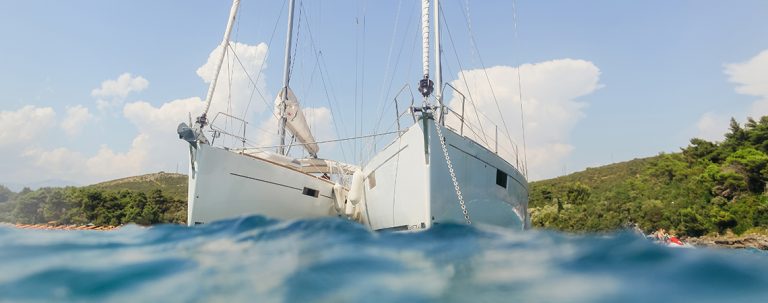
Best Cleaner for Fiberglass Boat – 2021 Reviews
Amazon Disclosure
DesperateSailors.com is a participant in the Amazon Services LLC Associates Program, an affiliate advertising program designed to provide a means for sites to earn advertising fees by advertising and linking to Amazon.com. As an Amazon Associate, we earn from qualifying purchases. Amazon and the Amazon logo are trademarks of Amazon.com, Inc., or its affiliates.
Please refer to our Privacy & Affiliate policy for more details.
- Sailing Simplified: The Ultimate Guide to Small Sailboats
The appeal of sailing has never waned, but the recent surge in interest towards small sailboats has opened up a new avenue for enthusiasts and beginners alike. The charm of these compact vessels lies not just in their maneuverability and affordability, but in the very essence of sailing they encapsulate. Small sailboats offer a gateway to the vastness of the sea, with the promise of adventure, learning, and community. This article delves deep into the world of small sailboats, covering everything from choosing the right type to the joys of being part of a vibrant sailing community.
Understanding the Appeal of Small Sailboats
Small sailboats, with their ease of handling, offer an unparalleled opportunity for sailors to develop a deep, hands-on understanding of the fundamentals of sailing. The affordability of these boats also makes sailing an accessible hobby for a wider audience, breaking down the financial barriers that larger vessels uphold. Moreover, the versatility of small sailboats means there’s something for every sailor's taste. Whether it's the thrill of racing, the calm of a leisurely day out on the water, or the joy of exploring new coastlines, these boats have something to offer to everyone.
Types of Small Sailboats and Their Unique Features
The world of small sailboats is rich and varied, encompassing a range of designs each suited to different sailing needs. Dinghies, for instance, are the perfect starting point for those new to sailing. Their simplicity and small size make them ideal for learning basic sailing skills. For those looking for a bit more stability and space, catamarans, with their dual hulls, offer an excellent option. They provide a comfortable sailing experience without compromising the intimate connection with the sea that small sailboats offer. Daysailers, on the other hand, are designed for those looking for a balance between performance and convenience. Often equipped with a small cabin, they are perfect for short, enjoyable outings, offering a taste of adventure without the need for extensive preparation or commitment.
Selecting Your Perfect Small Sailboat
Choosing the right small sailboat involves considering several factors, including the purpose of the boat, your budget, and your skill level. It's important to reflect on what you want to achieve with your sailboat. Are you looking to race, or are you more interested in leisurely coastal explorations? Your budget also plays a crucial role, as it's not just the purchase price you need to consider but also the ongoing maintenance costs. Additionally, matching the boat to your skill level is vital. Opt for a vessel that challenges you enough to grow as a sailor but isn't too advanced to handle safely.
Read our top notch articles on topics such as sailing, sailing tips and destinations in our Magazine .
Check out our latest sailing content:
Maintenance, upkeep, and sailing techniques.
Owning a small sailboat is a commitment to its care. Regular maintenance is essential to ensure the longevity and safety of your vessel. This includes seasonal preparations like winterization and routine checks for wear and tear. Moreover, mastering sailing techniques specific to small boats is crucial. These vessels require a nuanced understanding of wind and water dynamics due to their size. Learning basic maneuvers and safety measures not only enhances the joy of sailing but also ensures that your time on the water is safe and fulfilling.
The Community and Future of Small Sailboats
One of the most rewarding aspects of small sailboat sailing is the community. Joining clubs and associations or engaging with online communities can enrich your sailing experience. These platforms offer a wealth of knowledge, support, and camaraderie. They also provide opportunities to participate in races, social sails, and educational workshops, further deepening your connection to the sailing world. Looking ahead, the future of small sailboats is bright, with innovations aimed at making sailing more accessible, safer, and even more enjoyable for everyone.
In conclusion, small sailboats offer a unique blend of adventure, simplicity, and community. Whether you’re drawn to the thrill of racing, the peace of exploration, or the challenge of mastering a new skill, the world of small sailboats is inviting and expansive. With the right knowledge and preparation, anyone can embark on this rewarding journey, navigating the joys of compact sailing.
So what are you waiting for? Take a look at our range of charter boats and head to some of our favourite sailing destinations.
I am ready to help you with booking a boat for your dream vacation. Contact me.

Denisa Kliner Nguyenová
13 Best Beginner Sailboats with Cabin (For Any Budget)
Have you ever thought you couldn't afford a sailboat with a cabin? Think again. In this article, you will find 13 beginner sailboats that will suit your budget. We've considered various factors such as safety, ease of handling, and affordability in our selection. These sailboats offer cabins, providing a much-needed break during extended trips and offer the option of overnight stays.
The best beginner sailboats with cabins are Catalina 22, West Wight Potter 19, Com-Pac 23, Hunter 240, MacGregor 26, Montgomery 17, O'Day 22, Precision 18, San Juan 21, Sea Pearl 21, Sirius 22, Tanzer 22, and Ventura 23. Their prices can range from around $5,000 to $30,000.
Whether you're just dipping your toes into the world of sailing or planning on making it a lifelong passion, our list of beginner sailboats with cabins has something for everyone. This will help you focus on what really matters: enjoying your time at sea and mastering the art of sailing.
- Test-sail a few models so you can get a feel for how each boat handles and performs.
- Check out online forums to find user reviews and insights on each model you won't find anywhere else.
- Choose a sailboat that matches your current skill level, such as a small boat with simple rigging and easy handling.
- Identify how you plan to use your sailboat, whether for weekend cruising or for racing.
- Choose a boat that not only fits your budget but also ensures enough space and comfort for your activities.
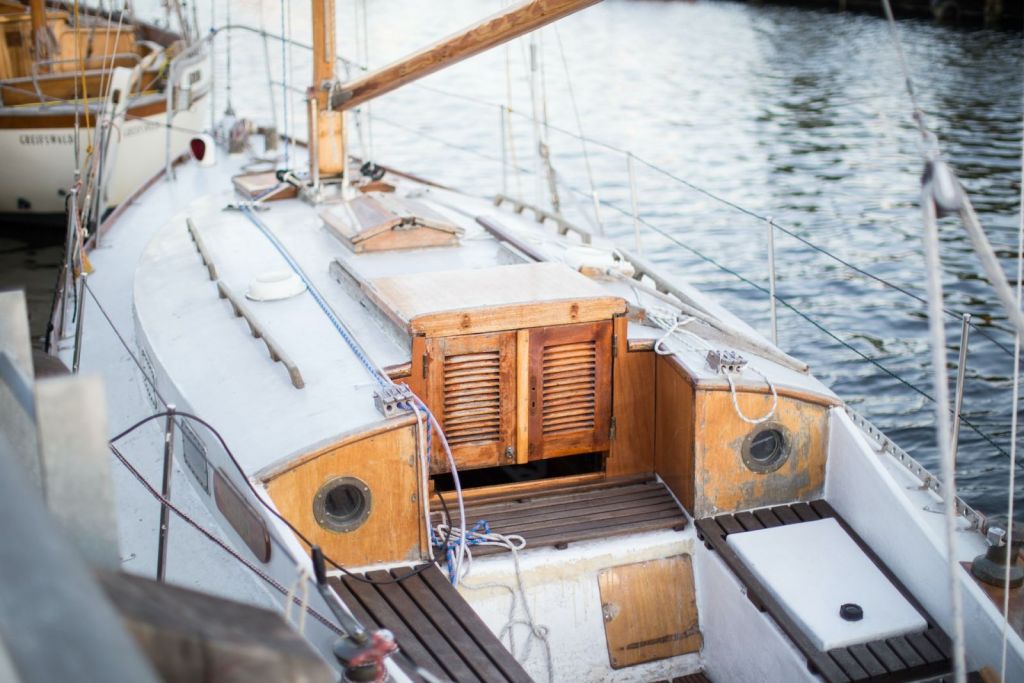
On this page:
Best beginner sailboats with cabin, let's decide on a sailboat with cabin, understand your needs when choosing a sailboat with cabin, factors to consider for your sailing needs and experience level.
| Estimated Cost | Length | Displacement | |
|---|---|---|---|
| $10,000 - $20,000 | 22 feet | 2,500 lbs | |
| $5,000 - $15,000 | 19 feet | 1,200 lbs | |
| $20,000 - $30,000 | 23 feet | 3,000 lbs | |
| $10,000 - $20,000 | 24 feet | 3,500 lbs | |
| $10,000 - $20,000 | 26 feet | 2,250 lbs | |
| $5,000 - $10,000 | 17 feet | 1,000 lbs | |
| $5,000 - $10,000 | 22 feet | 2,700 lbs | |
| $5,000 - $10,000 | 18 feet | 1,150 lbs | |
| $5,000 - $10,000 | 21 feet | 1,900 lbs | |
| $10,000 - $20,000 | 21 feet | 1,200 lbs | |
| $5,000 - $10,000 | 22 feet | 2,800 lbs | |
| $5,000 - $10,000 | 22 feet | 2,700 lbs | |
| $10,000 - $20,000 | 23 feet | 4,000 lbs |
1. Catalina 22 is a classic sailboat that has been popular for over 50 years
The Catalina 22 is an excellent choice for beginners due to its spacious cabin and easy handling. You can get it for $10,000–$20,000. You will appreciate its versatility and stability, which makes sailing more enjoyable and less intimidating. With a length of 22 feet, it's a great boat for beginners because it's easy to sail and has a comfortable cabin. It weighs 2,500 pounds.
2. West Wight Potter 19 is another good option for beginners
Your confidence will grow while sailing the West Wight Potter 19, a compact and sturdy sailboat. You can get it for $5,000–$15,000. Its compact design and shallow draft make it perfect for navigating tight spaces and shallow waters. It's a small sailboat with a cabin that's easy to handle and can be trailered. It weighs 1,200 pounds.
3. Com-Pac 23 is a larger sailboat that's still easy to handle
A great option for beginners seeking comfort is the Com-Pac 23. You can get it for $20,000–$30,000. This sailboat offers a cozy cabin and ample storage for your sailing adventures. Its stability and performance will undoubtedly enhance your sailing experience. It has a roomy cabin and is a good choice for those who want to spend longer periods of time on the water. It weighs 3,000 pounds.
4. Hunter 240 is a popular sailboat that's great for beginners
The Hunter 240 combines functionality and performance, making it an excellent beginner sailboat. You can get it for $10,000–$20,000. You will appreciate its roomy cabin and user-friendly design, which make sailing a breeze. It has a large cockpit and a comfortable cabin, making it a good choice for day sailing or weekend trips. It weighs 3,500 pounds.
5. MacGregor 26 is a versatile sailboat that can be used for both sailing and powerboating
If versatility is essential for you, the MacGregor 26 fits the bill. You can get it for $10,000–$20,000. This sailboat easily adapts to both sailing and power boating , providing you with a unique and enjoyable experience on the water. It has a roomy cabin and is a good choice for those who want to explore both the water and the land. It weighs 2,250 pounds.
6. Montgomery 17 is a small sailboat with a cabin that's easy to handle and trailer
The Montgomery 17 offers a great sailing experience for those new to the sport. You can get it for $5,000–$15,000. You'll find its compact design and easy maneuverability make it an excellent choice for building your sailing skills. It's a good choice for beginners who want a simple, no-frills sailboat. It weighs 1,000 pounds.
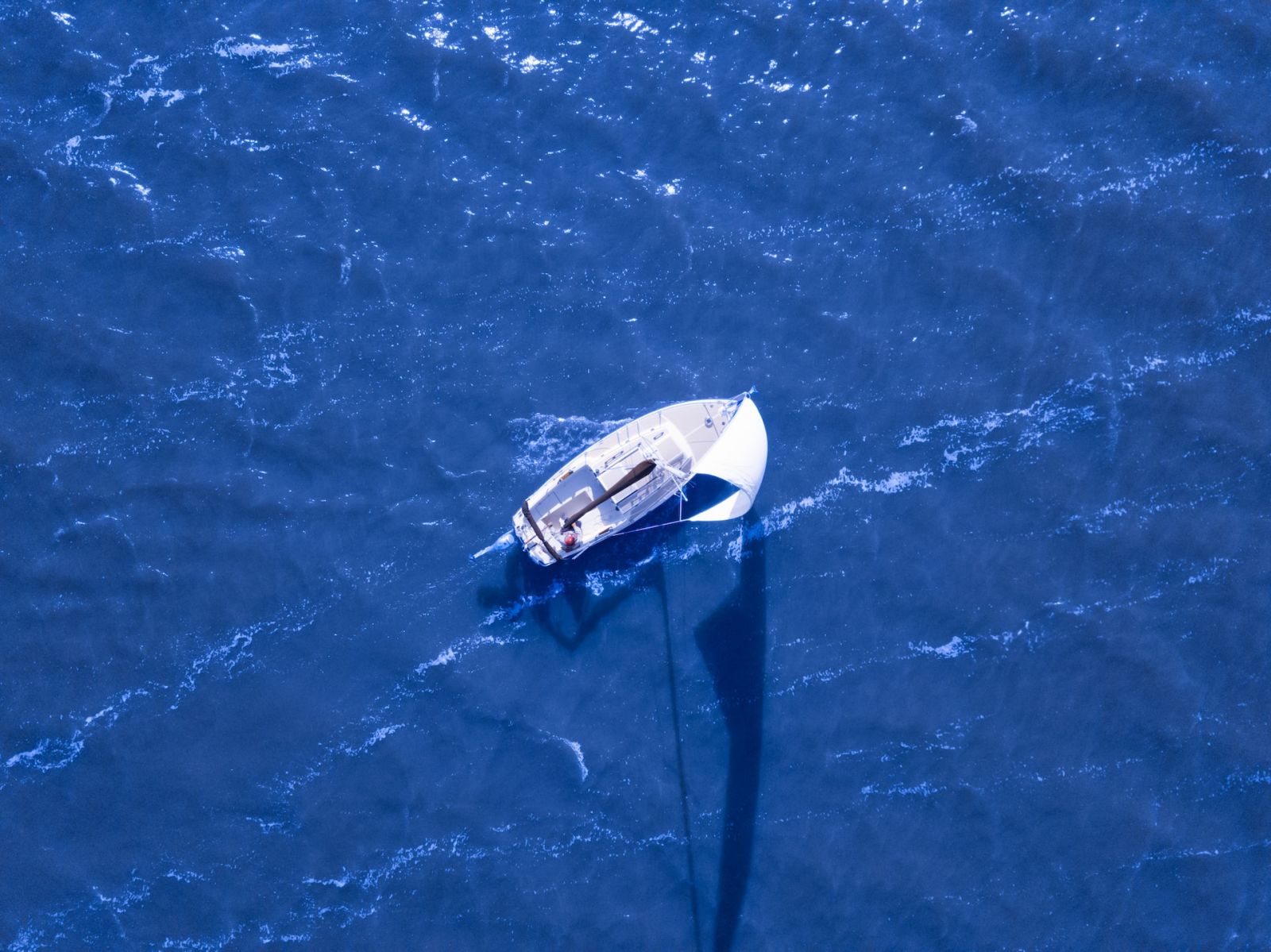
7. O'Day 22 is a classic sailboat that's easy to handle and has a comfortable cabin
Beginners will love the O'Day 22 for its simplicity and accessibility. You can get it for $5,000–$15,000. With a spacious cabin and dependable performance, this sailboat will ensure your sailing journey is smooth and enjoyable. It's a good choice for those who want to spend longer periods of time on the water. It weighs 2,700 pounds.
8. Precision 18 is a small sailboat with a cabin that's easy to handle and trailer
The Precision 18 is designed with beginners in mind. You can get it for $5,000–$15,000. You'll appreciate its manageable size and capability to navigate various sailing conditions with ease. It's a good choice for beginners who want a simple, no-frills sailboat. It weighs 1,150 pounds.
9. San Juan 21 is a popular sailboat that's great for beginners
The San Juan 21 is a fantastic option if you're just starting. You can get it for $5,000–$15,000. Its good performance and stability will allow you to develop your skills with confidence. It has a large cockpit and a comfortable cabin, making it a good choice for day sailing or weekend trips. It weighs 1,900 pounds.
10. Sea Pearl 21 is a unique sailboat that's great for beginners who want to explore shallow waters
You will love sailing the Sea Pearl 21, a beginner-friendly sailboat known for its shallow draft and stability. You can get it for $10,000–$20,000. Its compact design makes it easy to handle and perfect for weekend getaways. It has a shallow draft and a comfortable cabin, making it a good choice for those who want to spend time on the water and on the beach. It weighs 1,200 pounds.
11. Sirius 22 is a versatile sailboat that's easy to handle and has a comfortable cabin
The Sirius 22 has a comfortable cabin and user-friendly layout, which makes it an excellent choice for beginner sailors. You can get it for $5,000–$15,000. You'll enjoy sailing in various conditions thanks to its stability and performance. It's a good choice for those who want to explore both the water and the land. It weighs 2,800 pounds.
12. Tanzer 22 is a classic sailboat that's easy to handle and has a comfortable cabin
If you're looking for a beginner sailboat that's easy to handle, the Tanzer 22 is a great choice. You can get it for $5,000–$15,000. Its functional design and favorable performance make it a popular choice among novice sailors. It's a good choice for those who want to spend longer periods of time on the water. It weighs 2,700 pounds.
13. Ventura 23 is a popular sailboat for beginners that has a roomy cabin
Ventura 23 has a spacious cabin that can accommodate up to four people. You can get it for $10,000–$20,000. It's easy to handle and is a good choice for weekend trips or longer periods of time on the water. Its user-friendly features make it easy for beginners to navigate and enjoy their time on the water. It weighs 4,000 pounds.
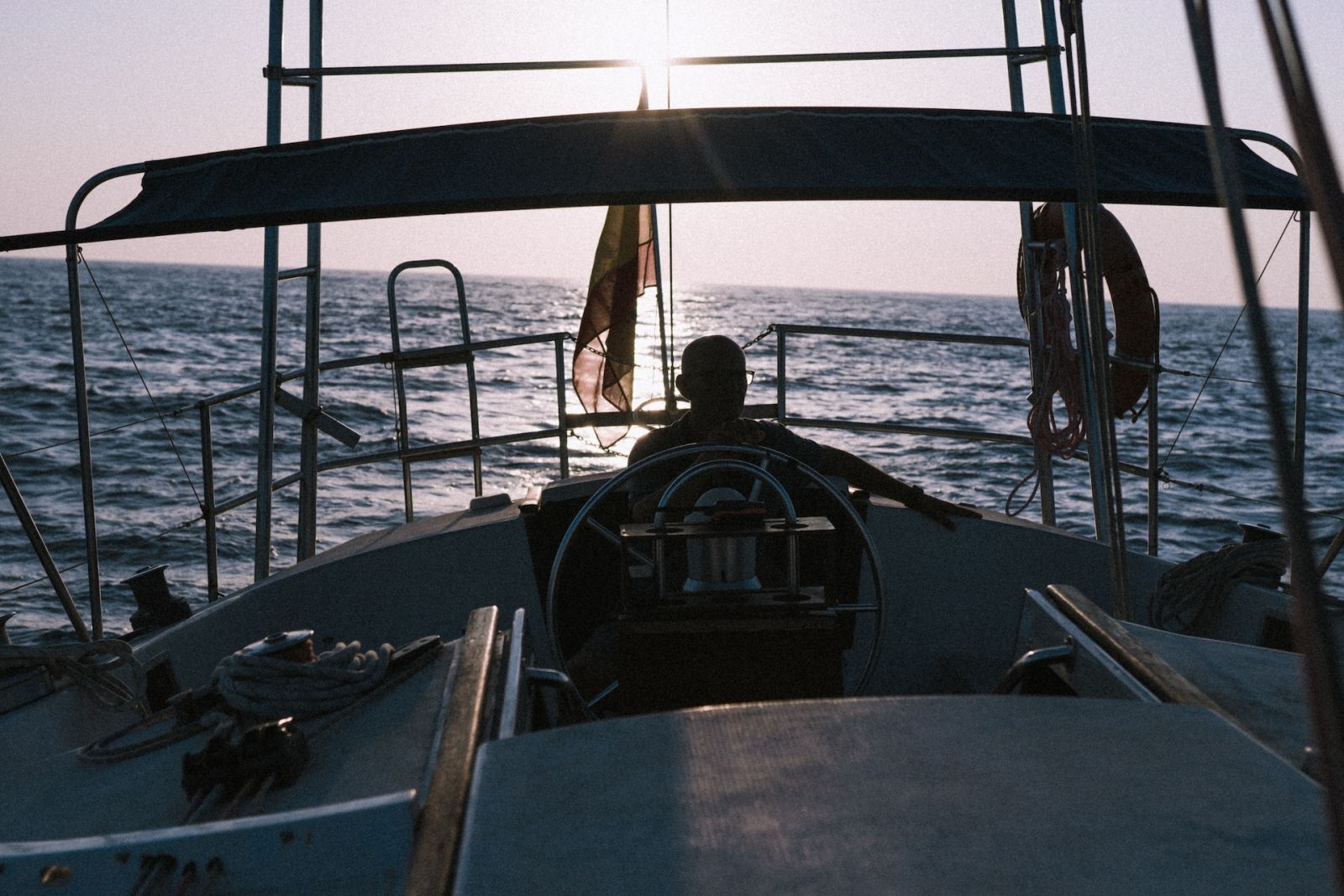
When choosing the perfect beginner sailboat with a cabin that suits your budget and needs, consider these factors:
Test sailing on a few models
This allows you to get a feel for how each boat handles and performs. Reach out to dealers or sailing clubs, as they may offer opportunities for you to try out different sailboats. Remember, your comfort and confidence on the water are crucial, so it's essential to choose a boat that feels right for you.
Research on various sailboat models
Invest some time in thorough research on various sailboat models within your budget. This will help you understand their features, strengths, and weaknesses. You can do this by consulting online resources, speaking with experienced sailors, and visiting boat shows.
Reviews from fellow sailors
Don't underestimate the power of reviews from fellow sailors. Reading the real-life experiences of others who have sailed on different boat models can provide valuable insights into their performance, maintenance, and overall satisfaction. Check out online forums, sailing magazines, and customer testimonials to gather a variety of opinions on the sailboats you're considering.
There are numerous online forums and communities dedicated to sailing enthusiasts and beginners where you can ask questions, share experiences, and learn from others who share your passion. In these spaces, you can find valuable advice and recommendations from experienced sailors on the best beginner sailboats for various purposes and budgets.
Some popular sailing forums and communities include:
- Cruisers Forum
- Sailing Anarchy
- SailNet Community
- Yachting and Boating World Forums
By participating in these communities, you'll be able to expand your knowledge, make new friends, and stay up-to-date with the latest trends and developments in the sailing world. Just remember to always approach online interactions with a friendly tone and an open-minded attitude, as this will help create a positive and supportive learning environment.
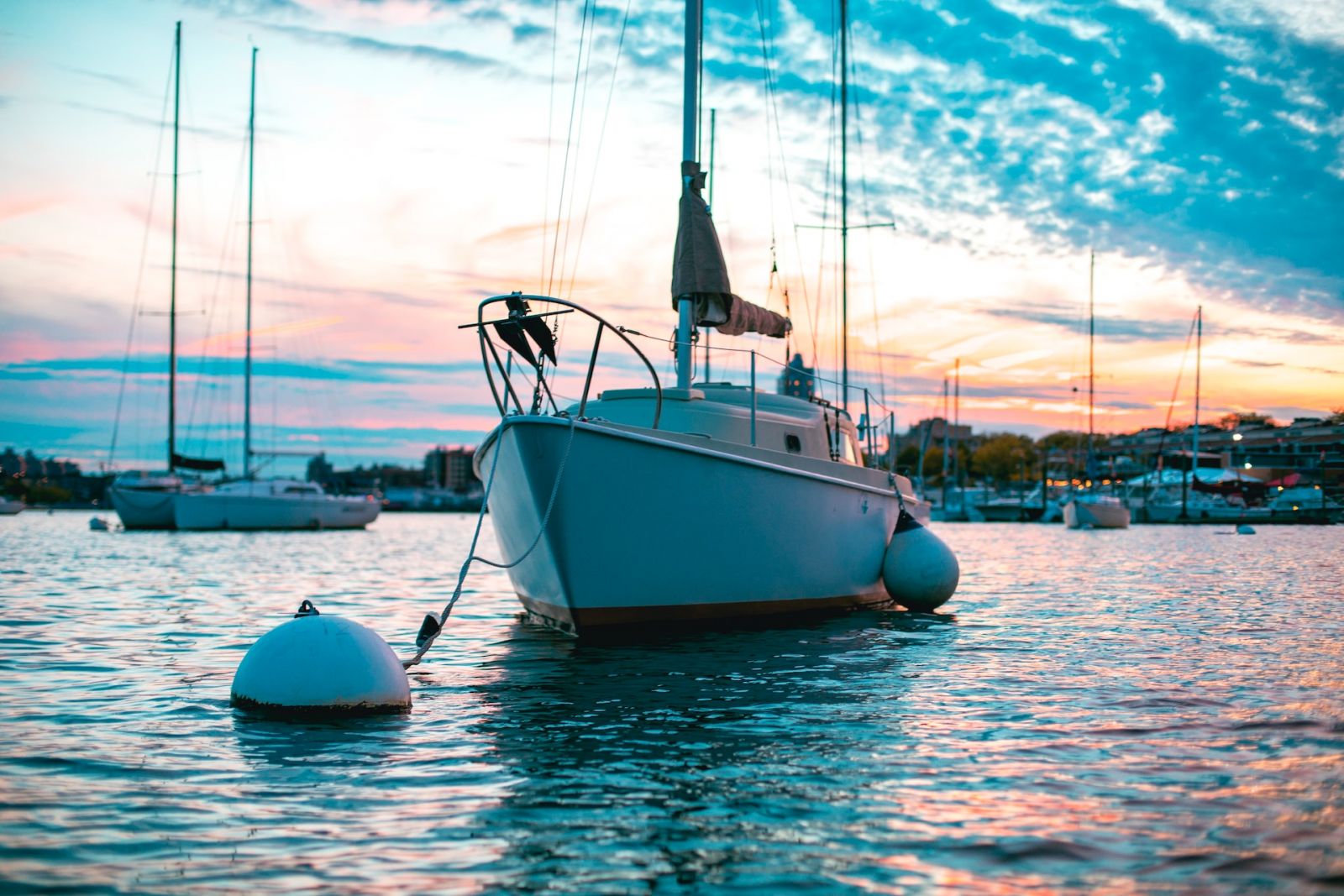
Consider the following factors to help you make the best decision that caters to your preferences and budget:
Sailing experience
As a beginner, it's crucial to choose a sailboat that matches your current skill level . Smaller boats with simple rigging and easy handling, like the Sunfish or Hobie Cats, are great for those who are just starting. As you gain experience, you may transition to larger vessels with more advanced features.
Preferred types of sailing activities
Always think about what type of sailing activities you prefer. Some people enjoy leisurely weekend trips , while others are more interested in racing. For example, the West Wight Potter is an excellent choice for weekend cruising, while the Challenger Trimaran is more performance-oriented for racers. Identifying how you plan to use your sailboat will greatly help you make the best choice for your needs.
Your budget for a sailboat with a cabin
Finding a sailboat within your budget range is essential, but also keep in mind the ongoing costs such as maintenance, mooring fees, insurance, and fuel. With realistic financial planning, you can make a wise investment in a sailboat that suits your needs and avoids future financial issues.
In this section, we will discuss the following important aspects when choosing the best beginner sailboat with a cabin: size and layout, ease of handling, and maintenance and upkeep.
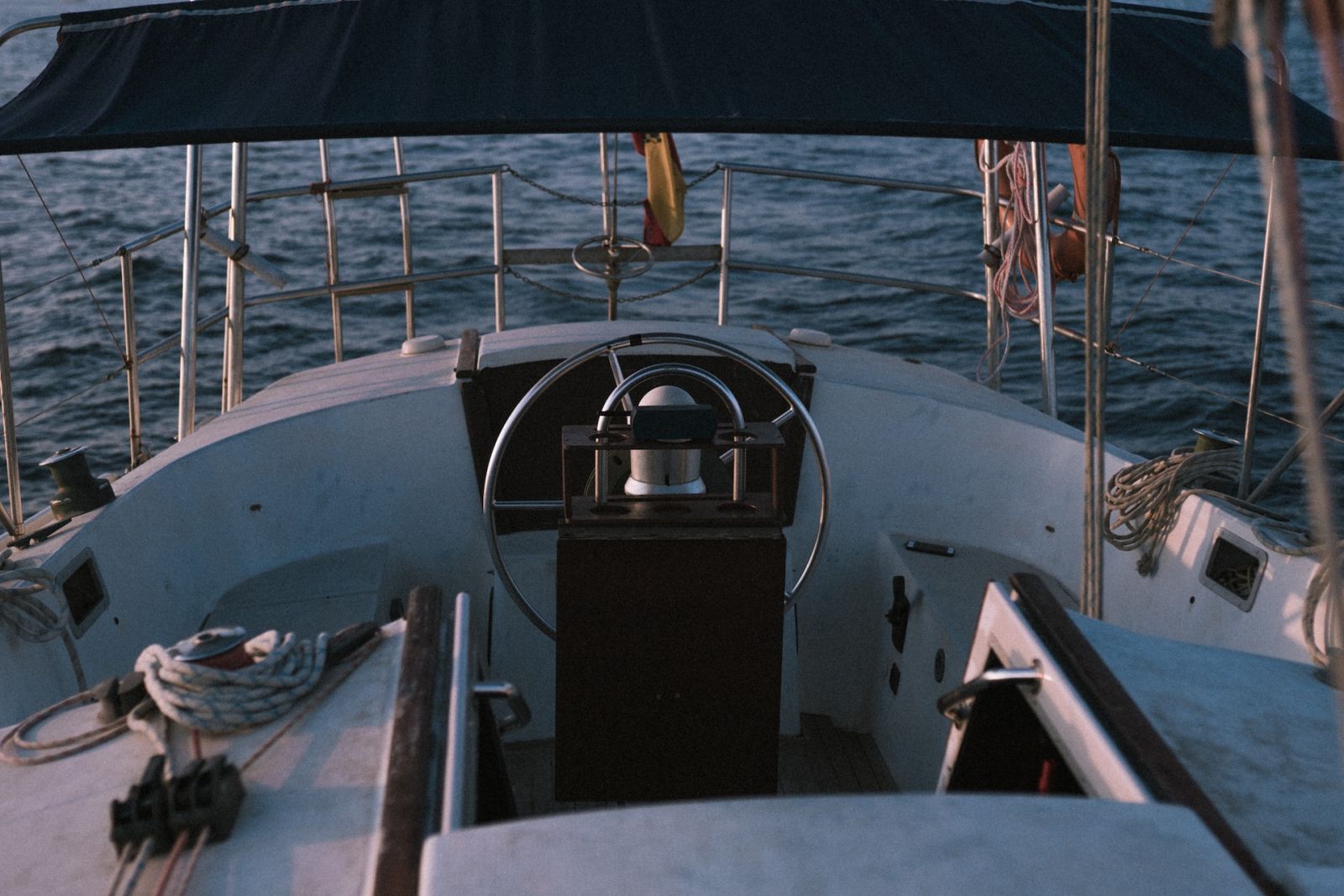
Size and layout of the sailboat
The size of the sailboat is an important consideration, especially if you plan to spend nights on board or have guests join you. Choose a boat that not only fits your budget but also ensures enough space and comfort for your activities. A good starting point might be boats between 22 and 30 feet in length, offering a combination of living space, stability, and sailing capabilities.
Think about the layout of the cabin and the overall interior design. Make sure there are enough berths for everyone staying on board, and consider the placement of the galley, head, and storage areas. Keep in mind that a well-designed layout can make a small space feel larger and more comfortable.
Ease of handling the sailboat
As a beginner, it's crucial to select a sailboat that is easy to handle and maneuver. Tiller steering is a great choice for beginners, as it helps you gain a better understanding of the boat's direction and the wind's force. Look for boats with simple rigging, easy-to-reach controls, and a responsive helm. This will ensure a smoother and more enjoyable learning experience as you build your confidence in sailing.
Maintenance and upkeep of the sailboat
Owning a sailboat comes with the responsibility of regular maintenance to keep it in top shape. Familiarize yourself with the costs and tasks associated with upkeep, such as cleaning, painting, and inspecting critical components. Choose a boat with a proven history of durability and low-cost maintenance, so you don't end up dedicating all your time and money to its upkeep. Fiberglass hulls, for example, tend to be easier to maintain than wooden ones.
Duane Stallings
Who makes the “Ventura 23” that weighs 4000 lbs? I can’t find it anywhere.
Leave a comment
You may also like, sailboat parts explained: illustrated guide (with diagrams).
When you first get into sailing, there are a lot of sailboat parts to learn. Scouting for a good guide to all the parts, I couldn't find any, so I wrote one myself.
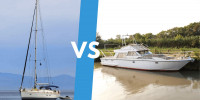
Sailboat vs. Powerboat: What's the Best Liveaboard?
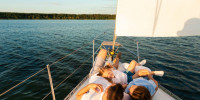
Choosing the Best Family Sailboat (Tips by Expert)
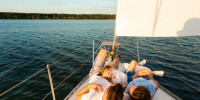
13 Best Liveaboard Sailboats (under 30 & 50 ft)
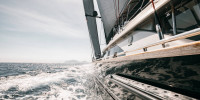
41 Sailboat Cruising Essentials for Long Trips
- BOAT OF THE YEAR
- Newsletters
- Sailboat Reviews
- Boating Safety
- Sails and Rigging
- Maintenance
- Sailing Totem
- Sailor & Galley
- Living Aboard
- Destinations
- Gear & Electronics
- Charter Resources
- Ultimate Boating Giveaway

20 Best Small Sailboats for the Weekender
- By Mark Pillsbury
- Updated: May 24, 2024
In order to go cruising, most of us require a sailboat with a head, a galley, and bunks. The boat, likely a 30-footer and more often a 40-footer, will have electronics for navigation and entertainment, refrigeration if the trip is longer than a coastal hop, an engine for light wind, and, depending on our appetites for food and fun, perhaps a genset to power our toys and appliances.
To go sailing , however, all we really need is a hull, mast, rudder, and sail. To experience the pure joy of sheeting in and scooting off across a lake, bay, or even the open ocean, there’s nothing better than a small sailboat – we’re talking sailboats under 25 feet. You can literally reach out and touch the water as it flows past. You instantly feel every puff of breeze and sense every change in trim.
Some of the boats in this list are new designs, others are time-tested models from small sailboat manufacturers, but every one is easy to rig, simple to sail, and looks like a whole lot of fun either for a solo outing on a breezy afternoon or to keep family and friends entertained throughout your entire sailing season. This list is made up of all types of sailboats , and if you’re looking for a list of some of the best small sailboats for beginners, you’ll find exactly that here.
Any one of these popular boats could be labeled as a trailerable sailboat, daysailer, or even a weekender sailboat. And while most would be labeled as a one or two person sailboat, some could comfortably fit three or even four people.
– CHECK THE WEATHER – The weather changes all the time. Always check the forecast and prepare for the worst case. Safety Tip Provided by the U.S. Coast Guard
Marblehead 22 Daysailer
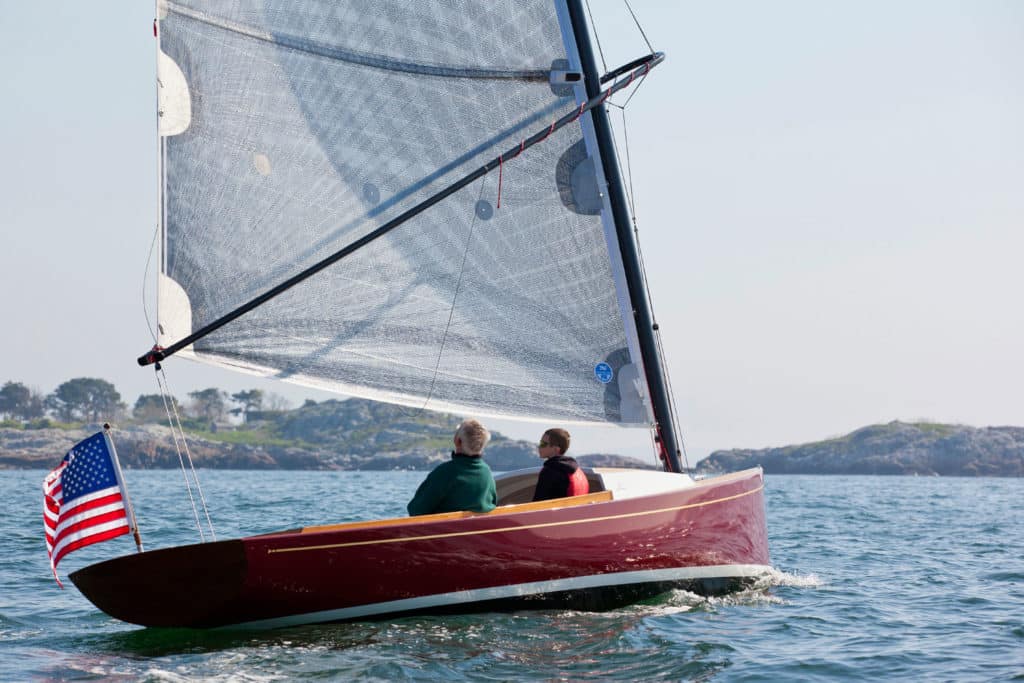
If you have an eye for elegant lines and your heart goes pitter-patter over just the right amount of overhang beneath a counter transom, the Marblehead 22 daysailer, designed by Doug Zurn and built by Samoset Boatworks in Boothbay, Maine, will definitely raise your pulse. Traditional-looking above the waterline and modern beneath, the cold-molded hull sports a deep bulb keel and a Hall Spars carbon-fiber mast with a wishbone rig and square-top main. The 11-foot-9-inch cockpit can seat a crowd, and a small cuddy forward will let you stow your friends’ gear for the day. samosetboatworks.com
Catalina 22 Sport
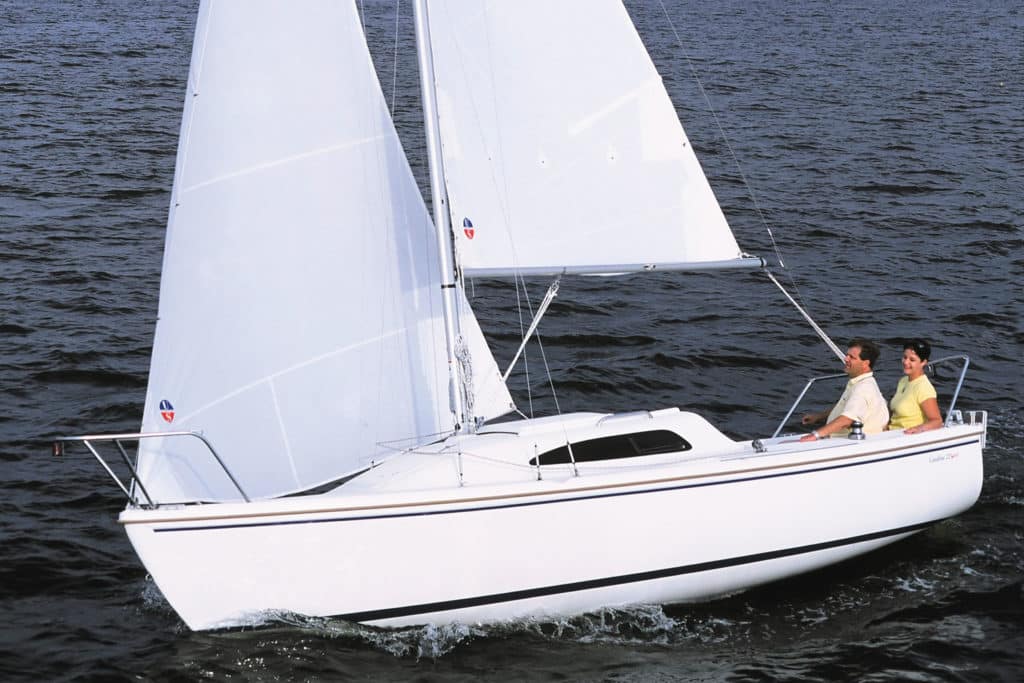
Many a harbor plays host to an active fleet of Catalina 22s, one of the most popular small sailboats over the years, given its basic amenities and retractable keel, which allows it to be easily trailered. Recently, the company introduced the Catalina 22 Sport, an updated design that can compete with the older 22s. The boat features a retractable lead keel; a cabin that can sleep four, with a forward hatch for ventilation; and a fractional rig with a mainsail and a roller-furling jib. Lifelines, a swim ladder, and an engine are options, as are cloth cushions; vinyl cushions are standard. The large cockpit will seat a crowd or let a mom-and-pop crew stretch out and enjoy their sail. It’s clear why the Catalina 22 is one of the best sailboats under 25 feet. catalinayachts.com
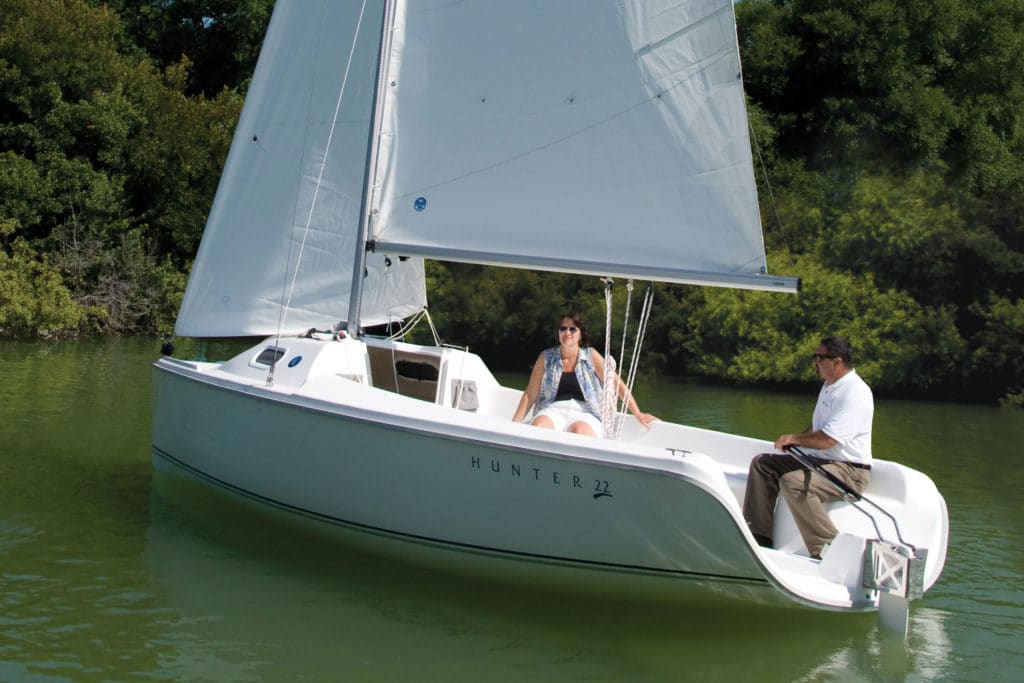
With its large, open-transom cockpit and sloop rig, the Hunter 22 makes a comfortable daysailer for family and friends. But with its cuddy cabin, twin bunks, optional electrical system, opening screened ports, and portable toilet, a parent and child or a couple could comfortably slip away for an overnight or weekend. Add in the optional performance package, which includes an asymmetric spinnaker, a pole, and a mainsheet traveler, and you could be off to the races. The boat features a laminated fiberglass hull and deck, molded-in nonskid, and a hydraulic lifting centerboard. Mount a small outboard on the stern bracket, and you’re set to go. marlow-hunter.com
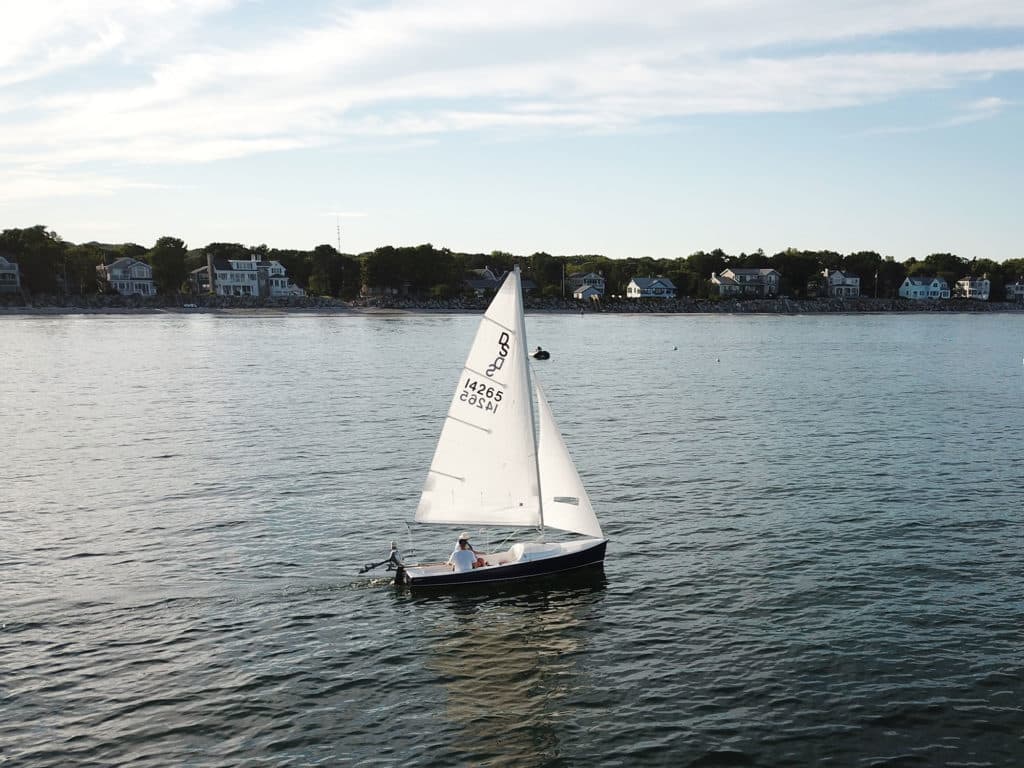
Not sure whether you want to race, cruise or just go out for an afternoon sail? Since 1958, sailors have been having a ball aboard the Uffa Fox/George O’Day-designed Daysailer. Fox, who in the 1950s was on the cutting edge of planning-dinghy design, collaborated with Fall River, Massachusetts boatbuilder O’Day Corp. to build the 16-foot Daysailer, a boat that features a slippery hull and a small cuddy cabin that covers the boat roughly from the mast forward. Thousands of Daysailers were built by various builders, and they can be found used for quite affordable prices. There are active racing fleets around the US, and new Daysailers are still in production today, built by Cape Cod Ship Building. capecodshipbuilding.com
BayRaider from Swallow Boats
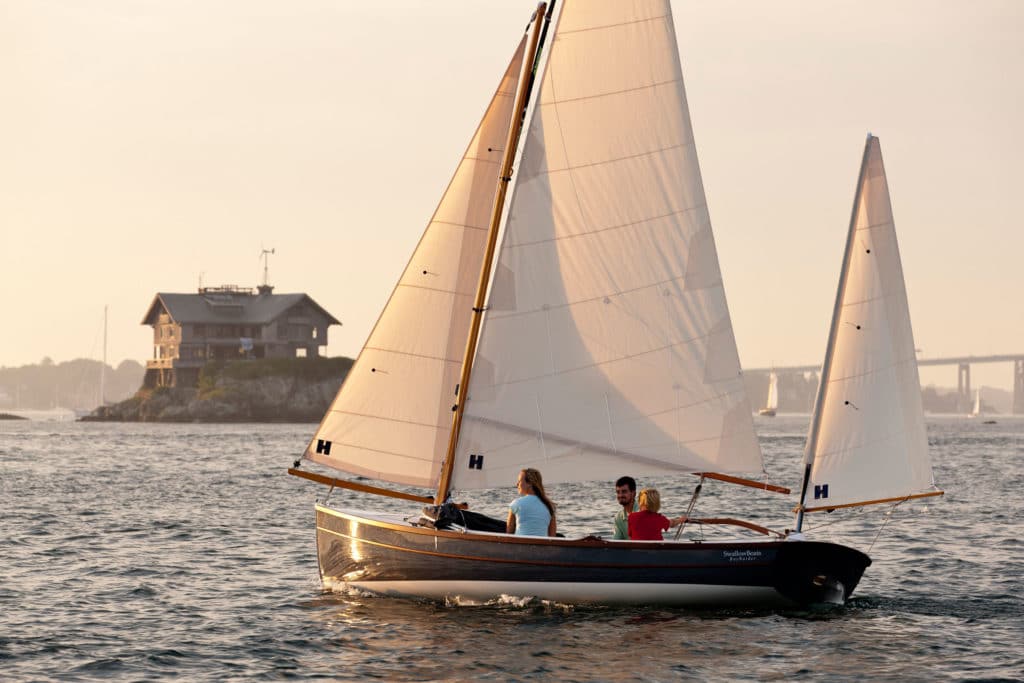
Easy to rig and trailer, the BayRaider from England’s Swallow Yachts is a relative newcomer to the small-boat market in the United States. Nearly all of its 19 feet 9 inches is open cockpit, though a spray hood can be added to keep the forward sections dry. The BayRaider is ketch-rigged with a gunter-style mainmast. The topmast and mizzen are both carbon-fiber, which is an option for the mainmast as well. The BayRaider can be sailed with a dry hull in lighter conditions or with 300 pounds of water ballast to increase its stability. With the centerboard and hinged rudder raised, the boat can maneuver in even the thinnest water.
$28,900, (904) 234-8779, swallowyachts.com
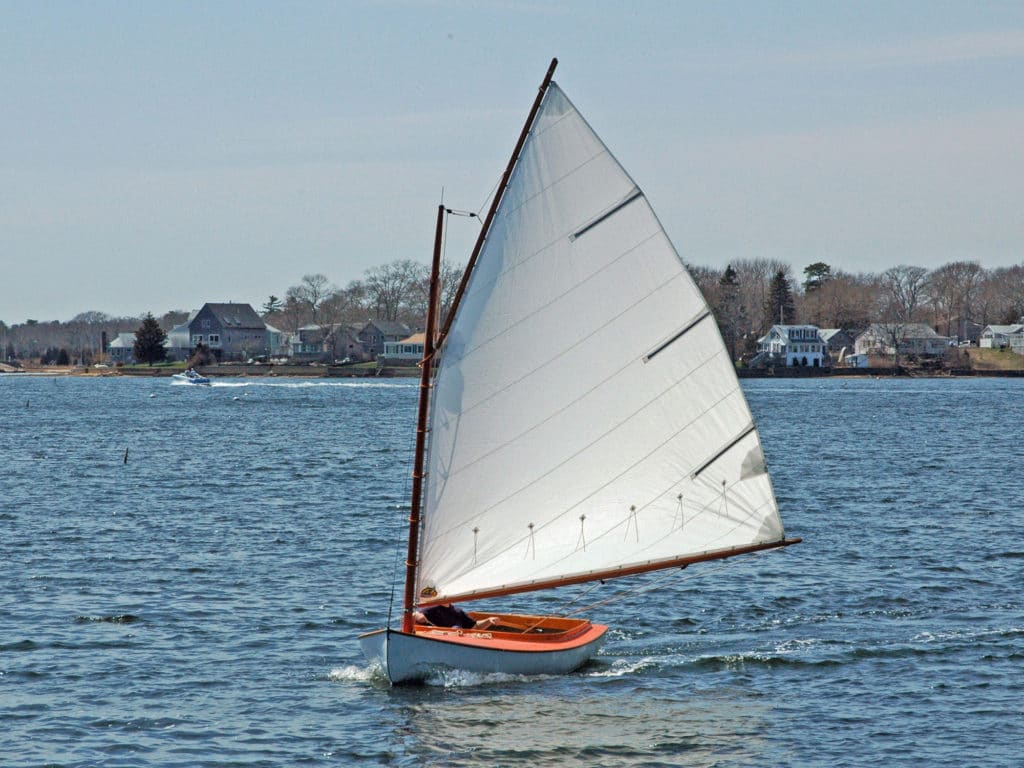
Big fun can come in small packages, especially if your vessel of choice happens to be the 12 ½-foot Beetle Cat. Designed by John Beetle and first built in 1921, the wooden shallow draft sailboat is still in production today in Wareham, Massachusetts at the Beetle Boat Shop. With a draft of just 2 feet, the boat is well-suited for shallow bays, but equally at home in open coastal waters. The single gaff-rigged sail provides plenty of power in light air and can be quickly reefed down to handle a blow. In a word, sailing a Beetle Cat is fun. beetlecat.com
– LEARN THE NAVIGATION RULES – Know the “Rules of the Road” that govern all boat traffic. Be courteous and never assume other boaters can see you. Safety Tip Provided by the U.S. Coast Guard
West Wight Potter P 19
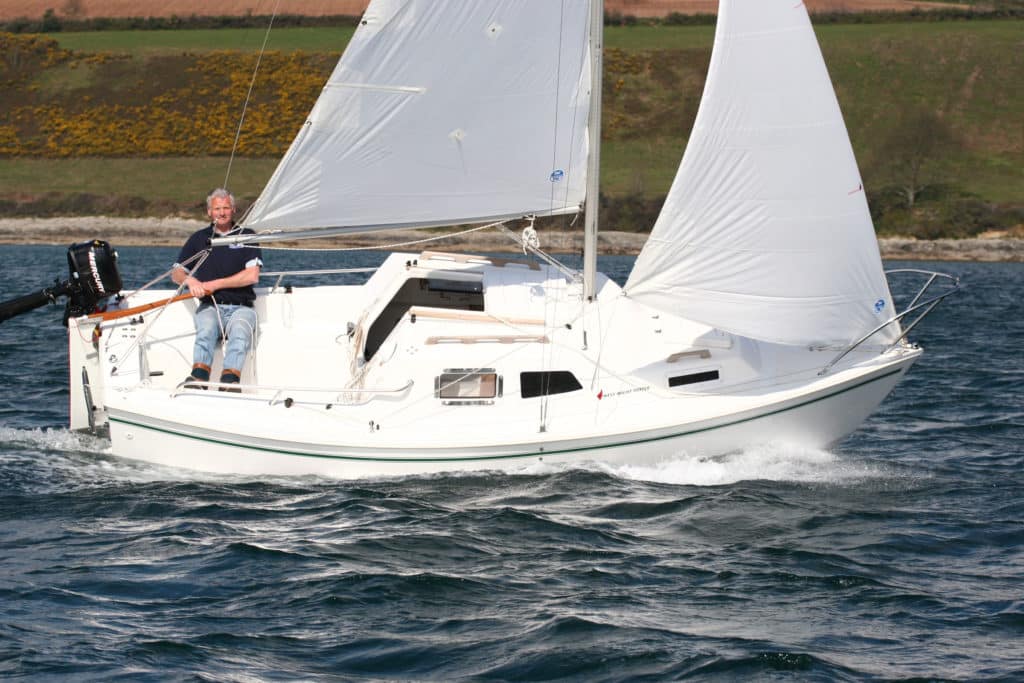
With berths for four and a workable galley featuring a cooler, a sink, and a stove, West Wight Potter has packed a lot into its 19-foot-long P 19. First launched in 1971, this is a line of boats that’s attracted a true following among trailer-sailors. The P 19′s fully retractable keel means that you can pull up just about anywhere and go exploring. Closed-cell foam fore and aft makes the boat unsinkable, and thanks to its hard chine, the boat is reportedly quite stable under way. westwightpotter.com
NorseBoat 17.5
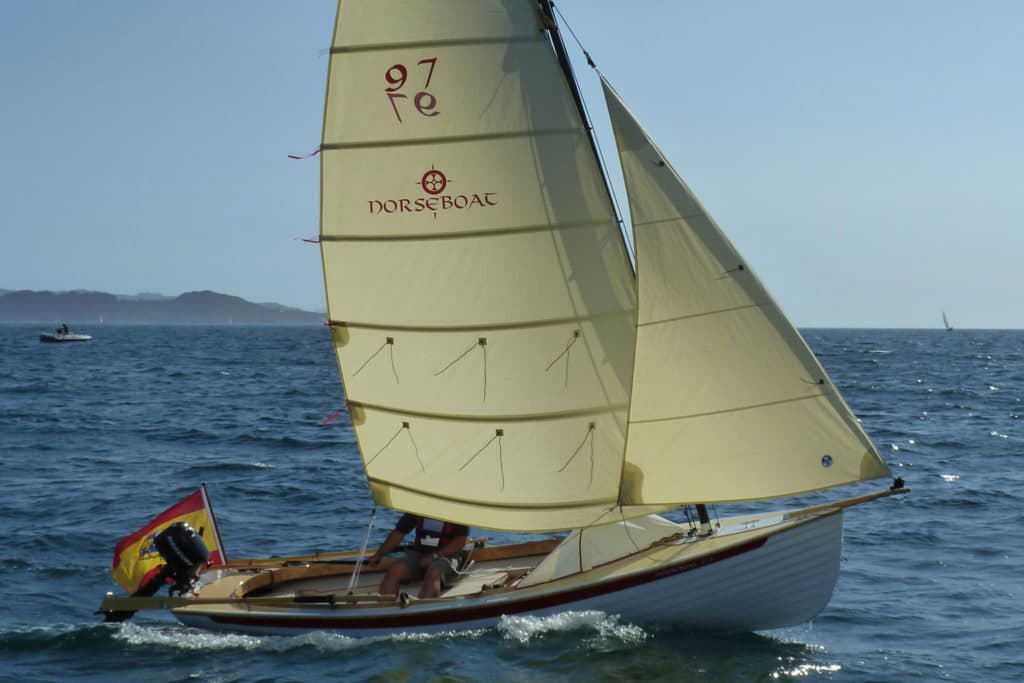
Designed for rowing and sailing (a motor mount is optional), the Canadian-built NorseBoat 17.5—one of which was spotted by a CW editor making its way through the Northwest Passage with a two-man crew—features an open cockpit, a carbon-fiber mast, and a curved-gaff rig, with an optional furling headsail set on a sprit. The lapstrake hull is fiberglass; the interior is ply and epoxy. The boat comes standard with two rowing stations and one set of 9-foot oars. The boat is designed with positive flotation and offers good load-carrying capacity, which you could put to use if you added the available canvas work and camping tent. NorseBoats offers a smaller sibling, the 12.5, as well; both are available in kit form.
$19,000, (902) 659-2790, norseboat.com
Montgomery 17
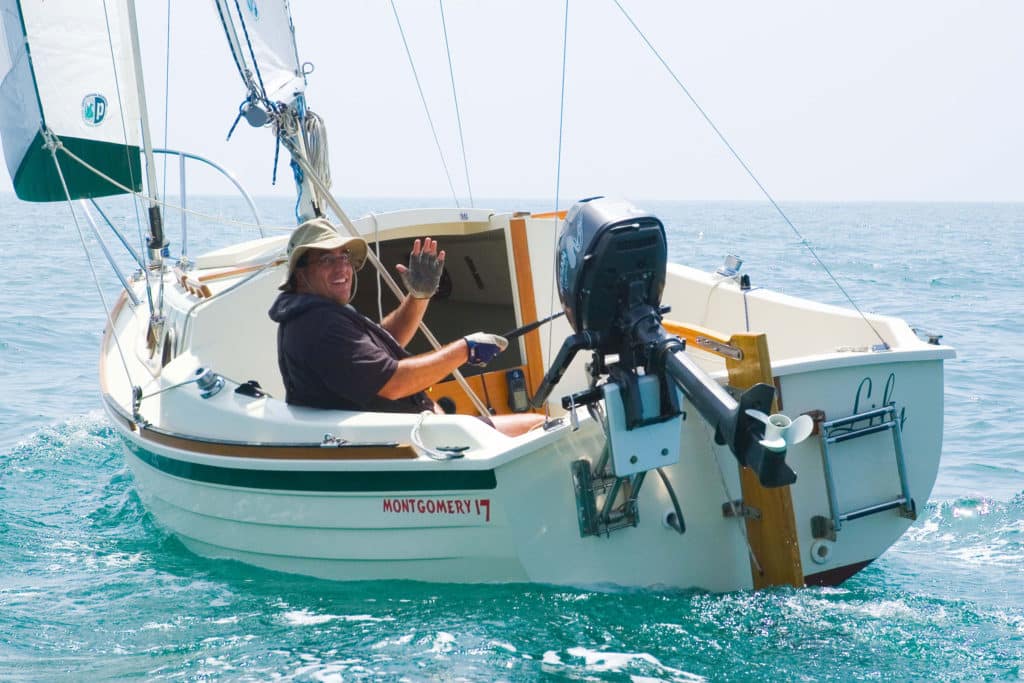
Billed as a trailerable pocket cruiser, the Montgomery 17 is a stout-looking sloop designed by Lyle Hess and built out of fiberglass in Ontario, California, by Montgomery Boats. With a keel and centerboard, the boat draws just under 2 feet with the board up and can be easily beached when you’re gunkholing. In the cuddy cabin you’ll find sitting headroom, a pair of bunks, a portable toilet, optional shore and DC power, and an impressive amount of storage space. The deck-stepped mast can be easily raised using a four-part tackle. The builder reports taking his own boat on trips across the Golfo de California and on visits to California’s coastal islands. Montgomery makes 15-foot and 23-foot models, as well. If you’re in search of a small sailboat with a cabin, the Montgomery 17 has to be on your wish list.
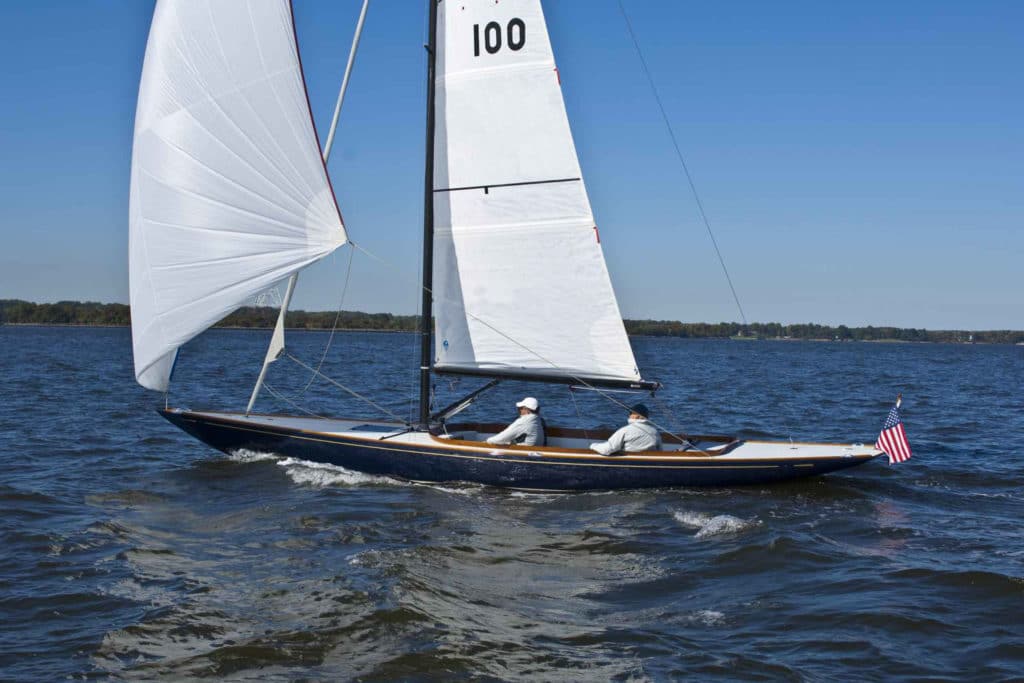
With long overhangs and shiny brightwork, the CW Hood 32 is on the larger end of the daysailer spectrum. Designers Chris Hood and Ben Stoddard made a conscious decision to forego a cabin and head in favor of an open cockpit big enough to bring 4 or 5 friends or family out for an afternoon on the water. The CW Hood 32 is sleek and graceful through the water and quick enough to do some racing, but keeps things simple with a self-tacking jib and controls that can be lead back to a single-handed skipper. A top-furling asymmetrical, electric sail drive and Torqeedo outboard are all optional. The CW Hood 32 makes for a great small family sailboat. cwhoodyachts.com
Sun Cat from Com-Pac
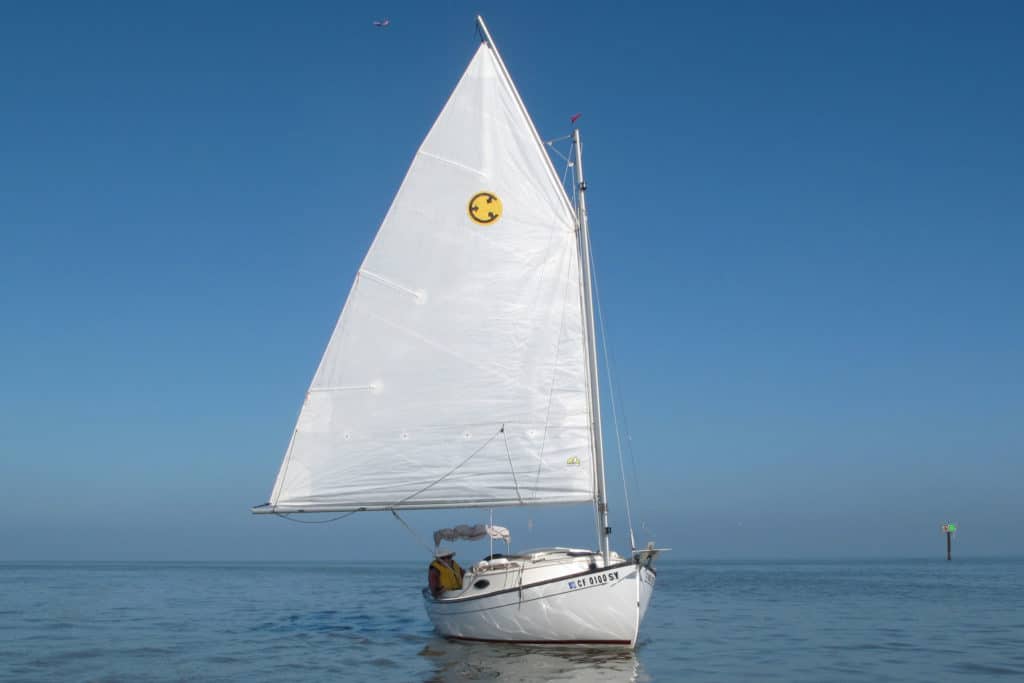
Shallow U.S. East Coast bays and rock-strewn coasts have long been graced by cat boats, whose large, gaff-rigged mainsails proved simple and powerful both on the wind and, better yet, when reaching and running. The 17-foot-4-inch Sun Cat, built by Com-Pac Yachts, updates the classic wooden cat with its fiberglass hull and deck and the easy-to-step Mastender Rigging System, which incorporates a hinged tabernacle to make stepping the mast a one-person job. If you want a personal sailboat ideal for solo sailing, the Sun Can is a great choice. Belowdecks, the twin 6-foot-5-inch berths and many other features and amenities make this cat a willing weekender.
$19,800, (727) 443-4408, com-pacyachts.com
Catalina 16.5
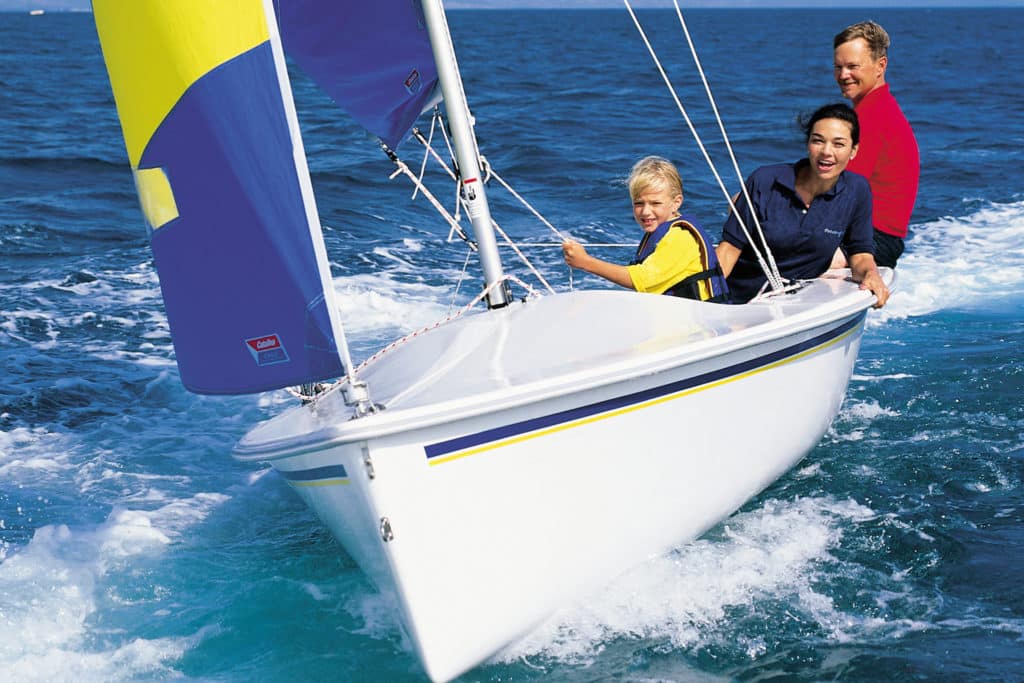
The Catalina 16.5 sits right in the middle of Catalina Yachts’ line of small sailboats, which range from the 12.5 to the 22 Capri and Sport, and it comes in both an easy-to-trailer centerboard model and a shoal-draft fixed-keel configuration. With the fiberglass board up, the 17-foot-2-inch boat draws just 5 inches of water; with the board down, the 4-foot-5-inch draft suggests good windward performance. Hull and deck are hand-laminated fiberglass. The roomy cockpit is self-bailing, and the bow harbors a good-sized storage area with a waterproof hatch. catalinayachts.com
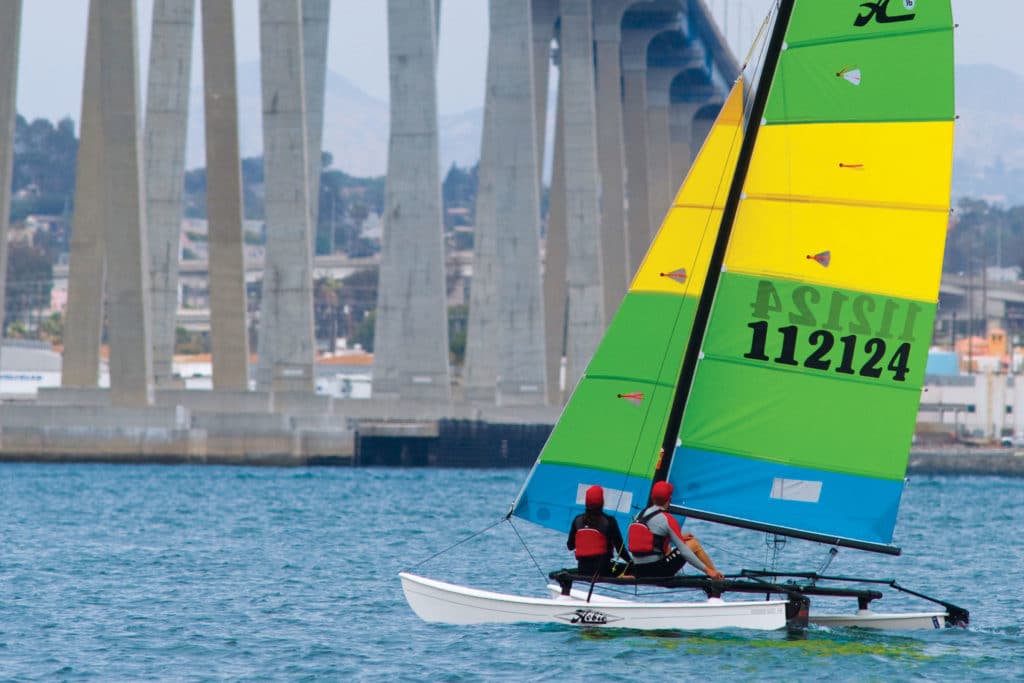
No roundup of best small sailboats (trailerable and fun too) would be complete without a mention of the venerable Hobie 16, which made its debut in Southern California way back in 1969. The company has introduced many other multihulls since, but more than 100,000 of the 16s have been launched, a remarkable figure. The Hobie’s asymmetric fiberglass-and-foam hulls eliminate the need for daggerboards, and with its kick-up rudders, the 16 can be sailed right up to the beach. Its large trampoline offers lots of space to move about or a good place to plant one’s feet when hanging off the double trapezes with a hull flying. The boat comes with a main and a jib; a spinnaker, douse kit, trailer, and beach dolly are optional features. hobiecat.com
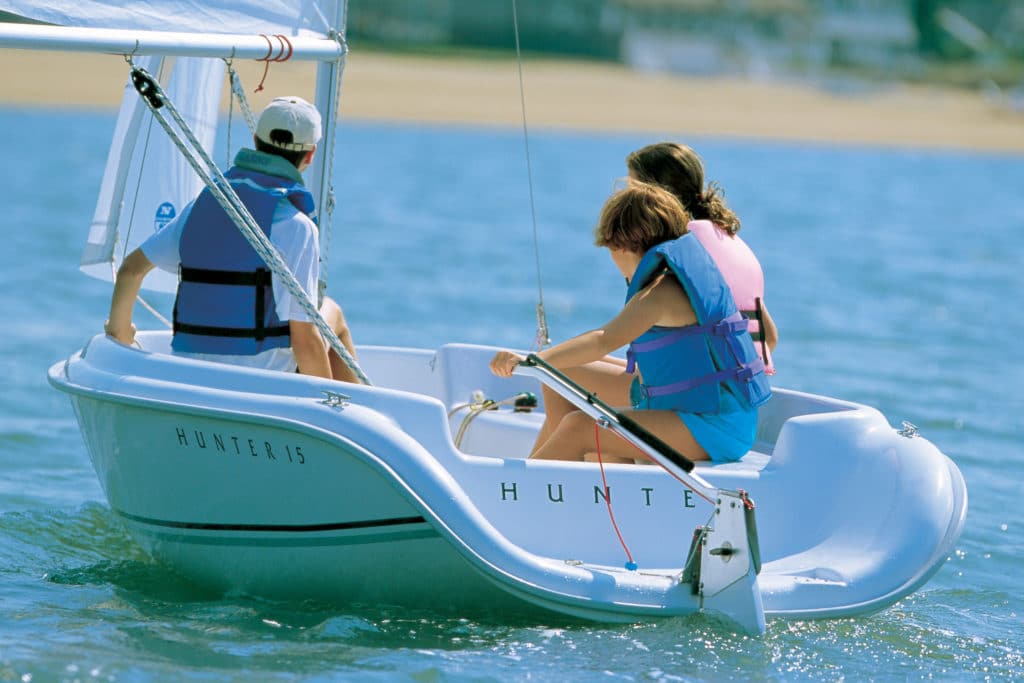
Novice sailors or old salts looking for simplicity could both enjoy sailing the Hunter 15. With a fiberglass hull and deck and foam flotation, the boat is sturdily built. The ample freeboard and wide beam provide stability under way, and the heavy-duty rubrail and kick-up rudder mean that you won’t have to worry when the dock looms or the going grows shallow. Both the 15 and its slightly larger 18-foot sibling come standard with roller-furling jibs.
$6,900/$9,500 (boat-show prices for the 15 and 18 includes trailers), (386) 462-3077, marlow-hunter.com
– CHECK THE FIT – Follow these guidelines to make sure your life jacket looks good, stays comfortable and works when you need it. Safety Tip Provided by the U.S. Coast Guard
Super Snark
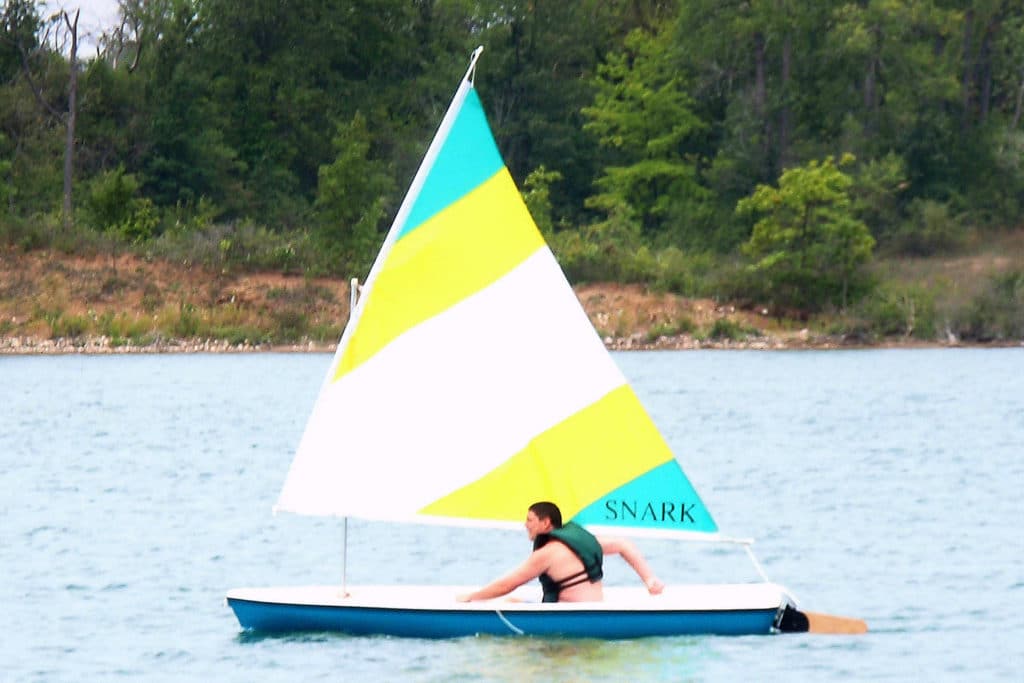
Under various owners, the Snark brand of sailboats, now built by Meyers Boat Co., has been around since the early 1970s. The Super Snark, at 11 feet, is a simple, easily car-topped daysailer that’s fit out with a lateen rig and sail. Billed as unsinkable, the five boats in the company’s line are built with E.P.S. foam, with the external hull and deck vacuum-formed to the core using an A.B.S. polymer. The Super Snark weighs in at 50 pounds, and with a payload capacity of 310 pounds, the boat can carry two.
$970, (800) 247-6275, meyersboat.com
Norseboat 21.5
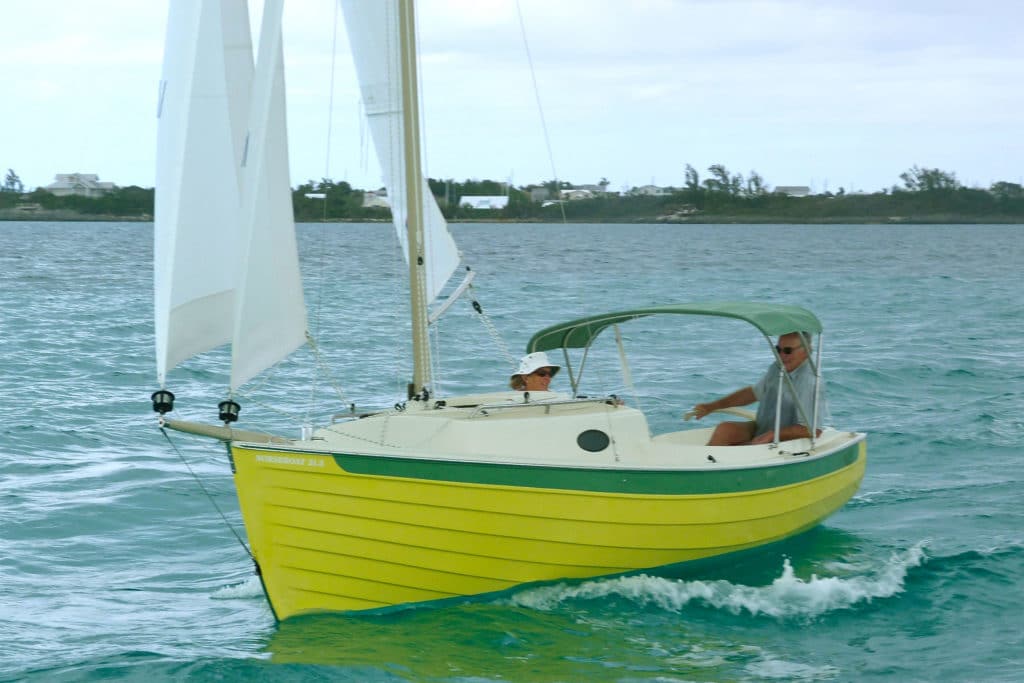
Built in Canada, the NorseBoat 21.5 is a rugged looking craft that comes in a couple of configurations: one with an open cockpit and small doghouse, and another with a smaller cockpit and cabin that houses a double berth for two adults and optional quarter berths for the kids. Both carry NorseBoat’s distinctive looking carbon fiber gaff-rigged mast with main and jib (a sprit-set drifter is optional), and come with a ballasted stub keel and centerboard. Because of its lightweight design, the boat can be rowed and is easily trailered.
$36,000 (starting), 902-659-2790, norseboat.com
Flying Scot
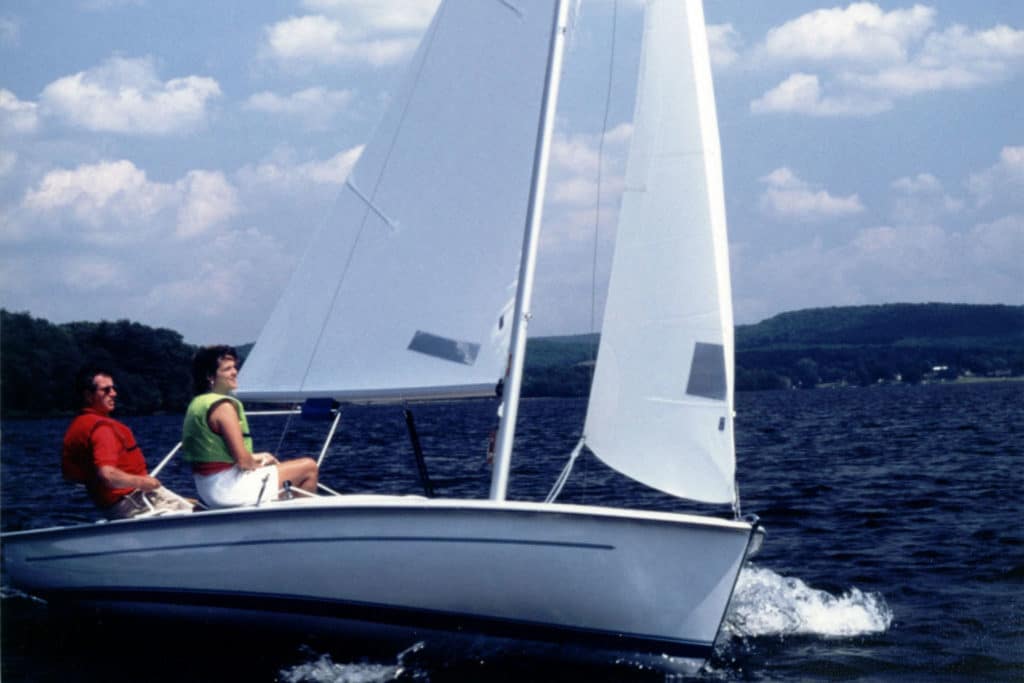
Talk about time-tested, the 19-foot Flying Scot has been in production since 1957 and remains a popular design today. Sloop rigged, with a conventional spinnaker for downwind work, the boat is an easily sailed family boat as well as a competitive racer, with over 130 racing fleets across the U.S. Its roomy cockpit can seat six to eight, though the boat is often sailed by a pair or solo. Hull and deck are a fiberglass and balsa core sandwich. With the centerboard up, the boat draws only eight inches. Though intended to be a daysailer, owners have rigged boom tents and berths for overnight trips, and one adventurous Scot sailor cruised his along inland waterways from Philadelphia to New Orleans.
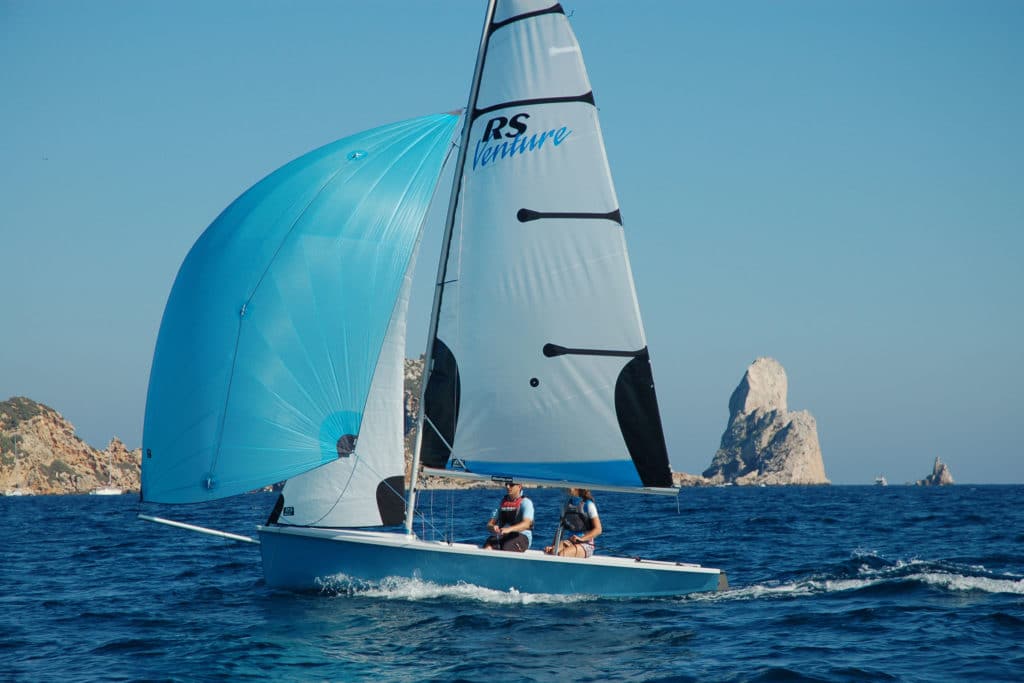
Known primarily for its line of racing dinghys, RS Sailing also builds the 16-foot, 4-inch Venture, which it describes as a cruising and training dinghy. The Venture features a large, self-draining cockpit that will accommodate a family or pack of kids. A furling jib and mainsail with slab reefing come standard with the boat; a gennaker and trapeze kit are options, as is an outboard motor mount and transom swim ladder. The deck and hull are laid up in a fiberglass and Coremat sandwich. The Venture’s designed to be both a good performer under sail, but also stable, making it a good boat for those learning the sport.
$14,900, 203-259-7808, rssailing.com
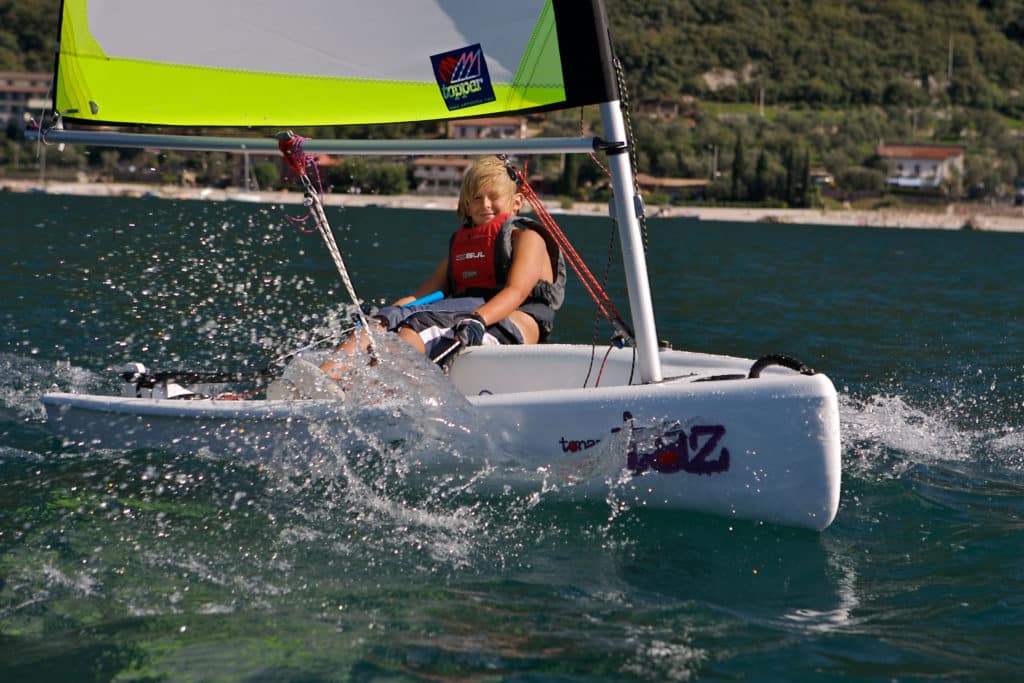
Topper makes a range of mono- and multihull rotomolded boats, but the model that caught one editor’s eye at Strictly Sail Chicago was the Topaz Taz. At 9 feet, 8 inches LOA and weighing in at 88 pounds, the Taz is not going to take the whole crowd out for the day. But, with the optional mainsail and jib package (main alone is for a single child), the Taz can carry two or three kids or an adult and one child, and would make a fun escape pod when tied behind the big boat and towed to some scenic harbor. The hull features Topper’s Trilam construction, a plastic and foam sandwich that creates a boat that’s stiff, light, and durable, and shouldn’t mind being dragged up on the beach when it’s time for a break.
$2,900 (includes main and jib), 410-286-1960, topazsailboats.com
WindRider WRTango
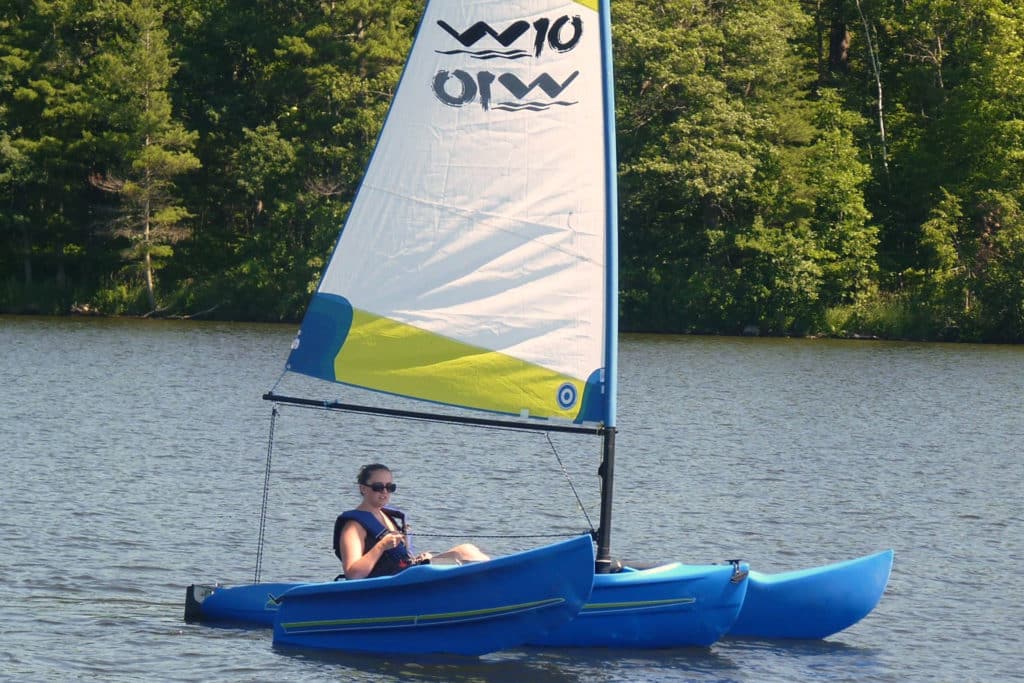
WRTango, a fast, sturdy, 10-foot trimaran that’s easy to sail, is the newest portable craft from WindRider International. It joins a line that includes the WR16 and WR17 trimarans. The Tango features forward-facing seating, foot-pedal steering, and a low center of gravity that mimics the sensation of sitting in a kayak. It weighs 125 pounds (including the outriggers and carbon-fiber mast), is extremely stable, and has single-sheet sail control. The six-inch draft and kick-up rudder make it great for beaching, while the hull and outriggers are made of rotomolded polyethylene, so it can withstand running into docks and being dragged over rocks.
$3,000, 612-338-2170, windrider.com
- More: 21 - 30 ft , Boat Gallery , day sailing , dinghy , Sailboat Reviews , Sailboats , under 20 ft
- More Sailboats

Sailboat Review: Dufour 41
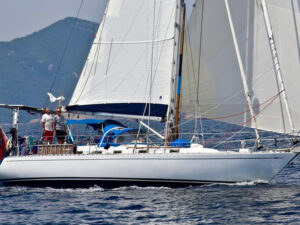
Pre-Owned: 1988 Hylas 47
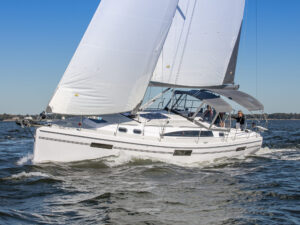
Catalina Introduces the 6 Series
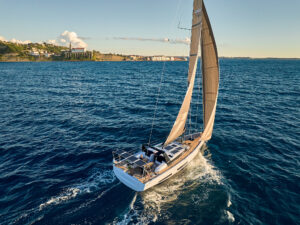
Sailboat Preview: Elan GT6 Explorer

Best Practices for Boat-Show Shopping

Savoring Superior: A Great Lakes Cruise To Remember
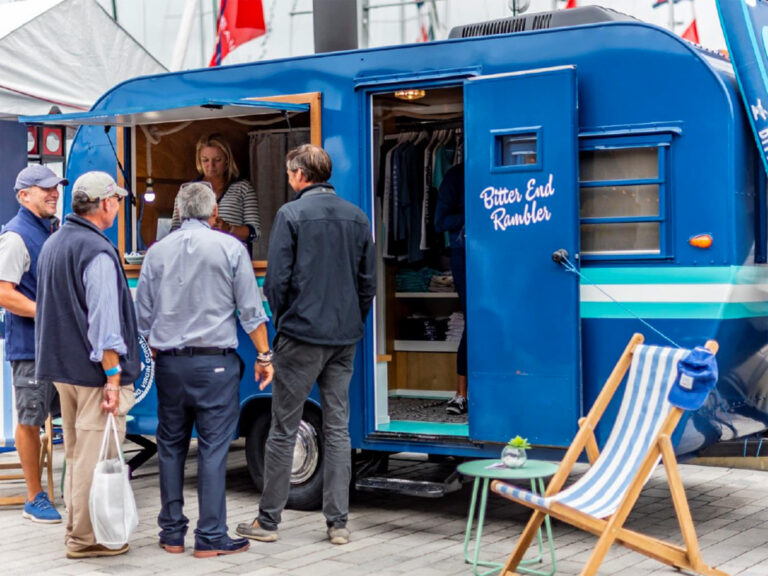
Point Your Compass Due South, Bitter End Yacht Club Reopens October 23rd.
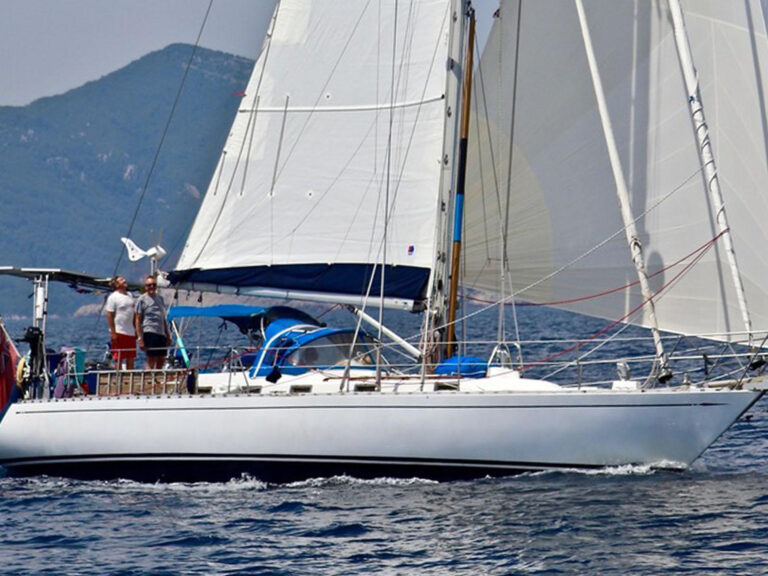
- Digital Edition
- Customer Service
- Privacy Policy
- Terms of Use
- Email Newsletters
- Cruising World
- Sailing World
- Salt Water Sportsman
- Sport Fishing
- Wakeboarding
- Articles and Guides
Choosing the Best Beginner Sailboat
9th jun 2023 by samantha wilson.

Sailing dates back thousands of years and is still one of the best-loved pastimes in the United States and across the world. Learning to sail brings many benefits, from gaining a whole new skillset, to getting out into the fresh air, improving your fitness, meeting like-minded people, and spending quality time with your family. If you’re considering learning to sail, start by checking out our guide on Getting into Sailing .
We all need to start somewhere and getting into sailing on the wrong type of boat for your experience level can leave you feeling frustrated. While the temptation to buy something filled with gadgets and plenty of space is there, remember that your love for sailing will come from feeling in control and at one with the ocean as you learn its every move. Simplicity is the key to that.
In this post we are focusing on the frequently asked question: "What are the best sailboats for beginners?" In short, all you really need is a hull, mast, rudder, and sail and you can be soaring along the coast or lake soaking up the sense of freedom that sailing brings. But of course buying a boat is never quite that simple, and with so much choice out there we have narrowed down the options.
Don’t forget, this doesn’t have to be your forever boat. As your skills improve and your horizons widen, you can upgrade to larger or more complex sailboats, but for this moment, consider the here and now and what boat will suit it.

A comfortable daysailer, the Marlow Hunter 18. Photo credit: Marlow Hunter
What Makes a Sailboat Good for Beginners?
As a general rule, the smaller the boat, the easier it will be to handle, although there are exceptions. The simplicity of the boat's sails and sail controls will also affect its beginner-friendliness. To start, we recommend choosing a boat that's easy to rig, lightweight, transportable, and simple to sail. From sailing dinghies to daysailers, weekender sailboats and trailerable boats, beginner boats are nifty and a lot of fun.
While safety and ease of handling are the main considerations for most beginners, there are several other factors that make a good beginner’s sailboat;
- An easily manageable size : A larger sailboat might feel more stable and allow you to venture farther or accommodate more people on board, but a smaller sailboat will certainly be easier to handle. Larger sailing yachts will need more complex rigs too, and as a beginner you want to be keeping everything as easy as you can while you get to grips with the act of sailing. Start off small and work your way up to bigger boats as your experience and confidence grows.
- A stable and comfortable ride over beauty : While you gain experience sailing, having a stable and safe sailboat under you will give you confidence. There will be bumps and scrapes and wrong maneuvers, and having a boat that can withstand these without expensive repairs will make them less stressful when they inevitably happen. Both dinghies and small keelboats make good starter boats; dinghies tend to be light and responsive, teaching lessons by feel as well as by eye; keelboats are more stable and can easily carry more and larger adults.
- A tiller for steering instead of a wheel: Having a tiller to steer with takes sailing back to the basics and allows you to get a better feel for the movement of the boat as you learn. The tiller is connected directly to the rudder, providing more feel for the flow of water past the boat. Unlike a steering wheel, you have to learn to move the tiller in the opposite direction that you want to turn, but you will quickly develop a more intuitive sense of the boat’s changes in speed and direction.
- An easy rig and simple sails: Again, simpler is always better for your first boat, and that goes for the rig and sails too. Sailing has a steep learning curve, so if you'll be sailing alone, we recommend that you choose a boat with a single mastand only one sail that you can set up by yourself quickly. You’ll have more on-the-water time and less setup and takedown time. If you’re storing your boat via trailer, be sure the mast is light enough to hoist into place by yourself. When it comes to the rigging, a halyard to hoist the mainsail and a sheet to control it are all you need. It’s possible to learn on a sloop-rigged with two sails, but it will be easier in that case if there are two of you learning together.
- Widely available model: By choosing a popular sailboat with lots on the used market you’ll find it easier to buy spares and parts as well as online resources to help you maintain it.
- Don’t spend too much: This is your first sailboat, and if you catch the sailing bug, it’ll most likely not be your last. As your skills improve you’ll want to get bigger models that will allow you to cruise farther and do more. The used boat market is huge, with online boat selling marketplaces such as Rightboat offering thousands of listings, so there are plenty of inexpensive, good quality small sailboats to be found.

The Laser, a sporty dinghy that can also be raced
20 of the Best Beginner Sailboat Brands
There are quite literally hundreds of brands and models of new and used small sailboats on the market and whittling it down to 20 of the best isn’t easy. But there are some sailboats which have stood the test of time and which remain today some of the best loved beginner sailboats out there. In no particular order, these are some of our favorites:
- Wayfarer sailboats
- Catalina sailboats
- Dart sailboats
- Sprint sailboats
- West Wight Potter sailboats
- Hobie sailboats
- Marlow-Hunter sailboats
- Skipper Craft sailboats
- Sabre sailboats
- Cape Dory sailboats
- Dufour sailboats
- Hurley sailboats
- MacGregor sailboats
- Beneteau sailboats
- Seaclipper sailboats
- Island Packet sailboats
- Jeanneau sailboats
The Best Beginner Sailboat Types
There are so many types of sailboats on the market that it’s hard to narrow down the best ones for a beginner. From dinghies to multihulls you have plenty of choice:
- Sailing dinghies: These small, lightweight sailboats are a good choice for a very first sailboat, their simplicity and ease of handling allowing beginners to get to grips with the skills they would need to advance to a more complex rig system. Accommodating one or two people with a single sail and single mast, these inexpensive boats offer the simplest back-to-basics sailing experience there is, and they can be easily taken apart for cheap storage or trailering. Their only downside is their easy ability to capsize but because of their weight they can be righted easily. The Optimist is the best known choice for children under 15 years of age, these bath-tub sized boats offering a lot of fun as well as safety and a great learning experience. For adults wanting to learn to sail, there are many similar boats on the market. The Pico, Sabot, Harteley 10 and RS Quba are commonly seen zipping across the waves near sailing clubs, while the Laser Bahia, Laser Vago, Topper Xenon and Topper Topaz are popular models for those looking for slightly bigger dinghies.

The International Optimist Dinghy, a youth learn-to-sail and racing boat
- Small catamarans Multi-hulls are renowned for their stability and therefore make excellent first sailboats. But size is a big factor and ‘small’ is the keyword here. Catamarans are fast and easy to maneuver, and the trampoline between the hulls makes for a fun sailing experience. The risk of capsizing with a catamaran is markedly lower than a monohull, but they’re also harder to upright if, in the unlikely event, they do go over. If there are cons to a catamaran it’s that they tend to cost more than monohulls and a marina berth will certainly cost more.
- Small sloops: While slightly more advanced than a dinghy, a small sloop is a great sailboat to learn with and to develop your skills on. It will still have one mast but can have up to three sails (usually one or two) which is good for perfecting your sailing techniques.
- Trailerable Sailboats : Ok, so this is necessarily a type of sailboat, but it’s certainly a major consideration when buying your first one. Being able to trailer your sailboat allows you to sail in different locations and conditions, therefore improving your skills. Of course the flip side is that you have to spend time setting it up each time you want go out on the water as opposed to have a ready rigged boat in a marina.
The Best Small Sailboats for Beginners
There are many models to choose from, with brand-new designs being launched each year alongside ever-popular models which have stood the test of time. Here we take a look at some best-loved beginner sailboats on the market.
The Best Beginner Sailboat with a Cabin: Catalina 16.5 and 22
Catalina is one of the best-known manufacturers of weekend sailboats and their range is extensive. The mid-range 16.5 and slightly larger Catalina 22 models both offer a simple set-up, fiberglass hull and deck, and a retractable keel for easy trailering. The 22 model offers a cabin which can sleep four, making it a cozy family boat for overnight trips. A large cockpit and swim ladder are added luxuries, but the real benefits for beginners is the simple fractional rig with a mainsail and a roller-furling jib.

A sloop-rigged daysailer, the Catalina 16.5. Photo credit: Catalina Yachts
The Best Beginner Cruising Sailboat: Hunter 15 and 22
These comfortable daysailer or weekend sailboats by popular manufacturer Hunter offer plenty of space with their large, open-transom cockpit, easy handling and fiberglass hulls. Whether you opt for the Hunter 15, 18 or the larger 22 with its twin bunks, they’re a great choice for teaching a child to sail, or for adult beginners to gain their confidence. But don’t be fooled into thinking it can’t get a real move on! A molded, anti-skid fiberglass and foam flotation hull means they have added safety and can easily be manned by one person.
The Best Beginner Sailboat for Coastal Sailing: Cape Dory 28
This is the largest beginner sailboat on our list, but if you’re planning long coastal cruises then you wouldn’t want to be doing so with anything much smaller. While it will take a bit more experience, the Cape Dory 28 is a solidly built and reliable vessel perfect for beginners. It has a full keel for stability in big seas, and it handles exceptionally well. Down below you’ve got the benefit of a small cabin, galley and head, and space to eat both inside and out. Because of their popularity and the sheer number of them built you can pick up one for a good price on the used market.
The Best Beach Sailboats for Beginners: Hobie Wave and Hobie 16
Hobie catamarans have been sailing off beaches all over the world for many years. The trailerable, sporty Hobie 16 sailboat is celebrating 50 years in manufacture—some 100,000 have been built during this time, a true testament to their popularity. As a multihull with a fiberglass and foam hull and a kick-up rudder board, the Hobie 16 can be sailed right up to the beach, and its trampoline allows for plenty of space to move around while learning new skills. Its newer little sister, the Hobie Wave, is even more rugged and simpler for beginners. Built with a rotomolded hull that's extremely durable, the Wave is just 13 feet long, has one sail, and is easily managed by one or two people.

The most popular beach catamaran ever, the Hobie 16. Photo credit: Hobie
The Best Liveaboard Sailboats for Beginners: West Wight Potter P 19
While liveaboard boats tend to be slightly larger than most beginner boats, if you want something relatively simple but with enough space for short-term living/cruising, the West Wight Potter P19 is a great option. For a weekend sailboat it packs a lot into a compact space, with berths for four people as well as a galley equipped with cooler, sink and cooker. Its retractable keel and flat-bottomed hull means you can explore virtually anywhere without even getting your feet wet, and it’s a great choice for trailering. For beginners, the West Wight Potter P19 is ideal thanks to its simple rig, good handling characteristics, easy handling and safety features—foam fore and aft means even if it is flooded the boat is unsinkable.
Common Challenges for Sailboat Beginners
It’s inevitable that things won’t always be smooth sailing when you’re starting out, but that’s also part of the fun of learning a new skill. Don’t forget to ask for help and advice along the way from those who have been sailing for a while, be kind to yourself when you don’t get things right, and enjoy the process and sense of achievement as you improve. Some of main hurdles to overcome include:
- Understanding the laws and regulations: It can seem like a complicated minefield in the beginning understanding what the boating laws are and which licenses and paperwork you need in order to sail in different parts of the U.S. and beyond. As well as taking sailing courses, there are lots of official online resources these days to give you a state-by-state overview. A good starting point are our guides on what qualifications you need as a first time boater , and which licenses you need to drive or sail a boat .
- Learning boating jargon: It can often sound like learning a whole new language and it’s easy to feel confused or frustrated by all the terminology there is to learn in boating. But it’s fun too, and soon you’ll be part of the club and using words that land-lubbers don’t understand. Taking a sailing course can help to speed up this learning process.
- Getting comfortable being on a sailboat: This might sound strange, but getting your sea legs is a big part of learning to sail and one that can take some people longer than others. While seasickness can rear its head at times, for most it's learning to get around on a moving vessel with ease and safety that takes a while to master.
- Tying knots: This can either be one of the most fun new things to learn or one of the most frustrating, but either way knots are a vital part of sailing for safety reasons. Start off easily with a few simple, common knots and just keep practicing. You’ll get the hang of it and be able to do them in your sleep in no time.
- Knowing the minimum amount of information to be safe and competent . In 2017 the US Coast Guard developed the American National Standards for Sailing Training (EDU-3). They then acknowledged sailing education bodies that teach to this standard. To date, NauticEd is the only education body meeting the standard. The course that meets the standard for small keelboats (up to 25 feet) is the NauticEd Skipper Small Keelboat Course. For an even more basic getting started course, NauticEd developed a 3-hour online course that covers the basics called Introduction to Sailing.
Related articles:
What are the Different Types of Sailboats?
Small Sailboat Types
This article was most recently updated in June 2023 by John Burnham
Written By: Samantha Wilson
Samantha Wilson has spent her entire life on and around boats, from tiny sailing dinghies all the way up to superyachts. She writes for many boating and yachting publications, top charter agencies, and some of the largest travel businesses in the industry, combining her knowledge and passion of boating, travel and writing to create topical, useful and engaging content.

More from: Samantha Wilson
Related Articles and Guides
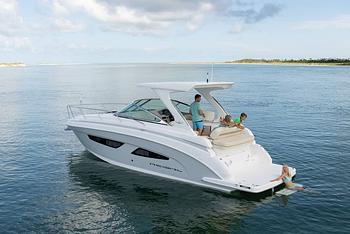
6th Sep 2024
The Best Mini Yacht Brands for Cruising and Luxury
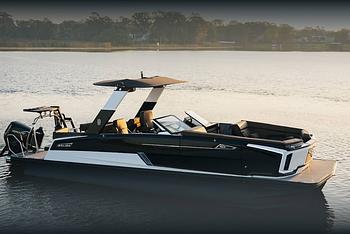
16th Aug 2024
Best Luxury Pontoon Boat Brands Have it All: Glamor, Speed, Fishing, Waterslides...
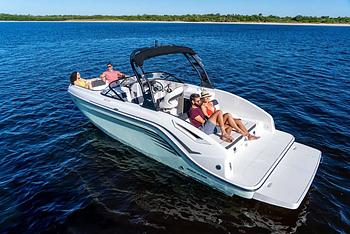
10th Aug 2024
Deck Boat vs. Bowrider: Which Runabout is Best?
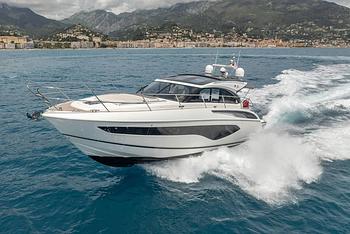
19th Jul 2024
The World’s Best Yacht Brands

- Explore Rightboat
- Boats for Sale
- Boating Articles
- Buyers Guide
- About RightBoat
- Sell Your Boat
- Boat Selling Advice
- All manufacturers
- All categories
- Are you a broker/dealer?
- Learn more about the Rightboat:HUB
Enter your email to keep up to date with the latest news
Join for free
Sign up now for free and discover how easy it is to keep up to date with THE latest boats for sale. Find your right boat, and tailor your voyage to finding your next boat.
Benefits of becoming a member:
- Set up tailored alerts
- Personalise your experience
- Download full specifications and broker details
- Keep tabs on your favourite boats
Are you a broker? Join as a Broker
Rightboat - join for free.
Do you have an account already? Login
Save this search
Save your search and receive new boats in your email..
You can unsubscribe from your alerts whenever you like. By pressing the button you accept the Legal Terms and conditions

Best Small Sailboat for Beginners
- Updated August 14, 2024
If you’re in the market for the best small sailboat for beginners, a few factors to consider are the boat’s durability, size, and it should be tiller steered. You should also make sure that it does not have any winches. To help you select the ideal boat for you, we’ve compiled some of the best sailboats for beginners.

Beginners take sailing lessons for a variety of reasons. It is a wonderful endeavor to take on, and many people do it for the chance to explore. Others do it because they enjoy the calmness of being out in the open water, while others may do it for competitive reasons.
Whatever reasons you might have for learning to sail, you need a dependable sailboat—particularly if you are new to sailing.
Luckily, you can learn to sail on any sailboat, but small ones are more beginner-friendly since they respond rapidly to your weight movements, wind shifts, and every command on the tiller. It wouldn’t make sense to see a novice helming a large sailboat in the middle of the Atlantic Ocean.
There are several sailboats available at various price points. However, it’s hard to tell which small boats are the best without naming the brands and models.
In this article, we’ll be bringing you some of the top small sailboats to get you started with your sailing journey. These sailboats are all easy to use and great for beginners. You’ll also know a bit more about sailboats and the features you need to look for.
Tell Tale Signs of a Good Beginner Sailboat
All these brands will tell you why you should choose one over the other. But how can you know whether a beginner sailboat is any good? Let’s find out!
Easy to sail
A good beginner sailboat is easy to captain. It shouldn’t capsize quickly and can withstand minor mishaps without dumping you into the water. And you don’t want something that’s too overpowered that it will terrify you when the wind kicks up.
Easy to rig
The best small sailboat for beginners should be simple to rig and assemble. For a trailerable boat, you’ll need a mast that you can raise and lower without straining your back or requiring a lot of maneuvering.
In the case of sailboats with a number of controls, there may be a variety of components to connect and change based on the wind conditions. And a recreational sailing boat could have just a few. For a beginner, you don’t want too many complexities in your sailing.
An excellent beginner sailboat can measure from 14 feet and can hold one to two adults. For your first sailboat, you should avoid going any larger than that.
Larger sailboats respond to steering and sail controls more slowly. And in case you try to get on and off the dock, it will have much more momentum. Keep in mind that the larger the boat, the greater the weight and force on all lines and sails.
Minimal controls
If you’re just learning to sail, you need to start with the basics. You’ll only need a halyard to hoist the mainsail and a sheet to manage it. That’s all you need to sail upwind, downwind, or in whatever direction. All the other controls are just extras.
Things To Consider in Finding the Best Small Sailboat for Beginners
Before buying a small sailboat, there are a few things you must consider.
Tiller Steering
Your sailboat should have tiller steering. Some people might confuse it for wheel steering, which is a different mechanism. The steering wheel will have a lot of drag and slop, which means you won’t be able to perceive how the boat reacts.
Since the tiller is tied directly to the rudder, feedback from your boat’s speed, course, and wind impact will be quickly observable. With a wheel, on the other hand, there is latency, and you won’t feel the rudder immediately.
Tiller steering is an excellent approach to learning how to sense your boat’s motions. It will be much simpler to maneuver your sailboat if you have an instinctive connection with it.
Make sure the sailboat you’re getting has cleats instead of winches. This can make learning to sail much easier. Sailboats with cleats are significantly easier to operate, endure less force from heavy winds, and are suitable for beginners of any age.
These boats often do not face the same stresses on the sails and gear as larger boats, which can be difficult to handle when the wind picks up.
With smaller boats, though, they may come equipped with winches, however, this is not the case. It is always critical to consult with the dealer if your boat includes winches to operate the sheets or halyards.
As a beginner, smaller boats will be easier for you to operate. You may benefit more from the stability of a larger boat, but it will be more difficult to navigate. If you’re just getting into sailing, a smaller boat will be a good place to start.
You can always up your boat size once you have a good grasp on everything associated with a smaller boat.
You will have the best buck for your money with a durable sailboat. You will be making some mistakes and that is expected. Finding a sailboat that can handle all of the bumps and bruises you will avoid a lot of problems.
Purchasing a Rotomolded boat is perfect. It’s a tough plastic material that, while it may not look as attractive as finished wood or even fiberglass, can survive much longer. These boats are also far less expensive, which makes them ideal for a beginner.
Why Should You Learn How To Sail?
Learning to sail is an exciting experience. It’s a practical skill that can turn into passion and open new opportunities for you. Sailing can also improve critical thinking and teamwork skills. If you are still on the fence about learning to sail, perhaps these benefits will help you decide to get into sailing.
It gives a sense of freedom
Sailing on the open water gives you a sense of freedom. With the right weather condition, there’s no other way to explore the waters than being able to set off at any moment. Any sailor will tell you how calming and liberating it is to be out in the water.

Creates community
Sailing forms tight-knit communities like sailing clubs and tournaments. Sailors ranging from professionals to casual amateurs share the same love for everything about messing around with boats.
Sailors see themselves as part of a unified community. This is regardless of their level of devotion to the sport. You can visit a local sailing club if you’re seeking a venue where you’ll be greeted warmly and accepted by the community.
Trains you for competition
Sailing competitions are both intense and entertaining. And it is a means of discovering your ability and willpower. Learning to sail prepares you for the potential of participating in a sailing competition. That tournament doesn’t have to be a huge one. You can go on a transatlantic race or a monthly event at your local club.
Things Beginner Sailors Should Know Before Buying a Sailboat
As a beginner, you are expected to experience some setbacks here and there. Sailing doesn’t always come easy to many novices. And this is true even for individuals who grew up among sailboats or from a family of sailors. It takes knowledge, talent, discipline, and instincts.
Below are a few of the most common hurdles that beginner sailors face. Understanding each one brings you awareness so you’d know that it’s alright to fail sometimes and you can always try again.
Familiarizing With Jargons
It might be difficult to learn the vocabulary and common sailing jargon. Those who grew up around sailboats may have learned a lot about such over the years. And for beginners, it might feel like you’re learning a whole new language. Understanding sailing terminology and basic regulations are critical as you learn to sail.
Much like learning how to drive a car on road and adhering to traffic rules, following maritime laws and safety regulations are crucial parts of being a sailor. Most states have a specific regulation that you need to follow. It is critical to understand who has the right of way, how to ask for help, and how and when to help others.
Many beginners struggle to tie a knot, which is fine. You could have trouble tying all of these tricky knots you’ve never done before. And you’ll also need to learn the different types of knots. This may sound like a lot of work, but it’s an essential part of learning to sail.
These knots have a purpose and need to be tied in the same manner otherwise the one attempting to untie them will be in danger.
Boats have complex structures. Understanding each element of a sailing boat and what function they perform is important. Since boats are small and have no extra space, you realize that everything on board has a function and is valuable in its own way.
You have a lot to discover in this area, so it could be necessary to spend some time learning in addition to time at the water.
The Best Small Sailboats for Beginners
Sailing, especially for beginners, is one of the best ways to spend a day on the water. However, it won’t be as fun without the right small sailboat. Here are some of the best sailboats for beginners you should know.
Sailing Dinghies
Sailing dinghies are classic beginner sailboats, making them an excellent choice if you’re just learning to sail. They are small, lightweight, low-cost vessels that are easy to operate. The dinghy cruising boats are also a popular type of sailing boat, particularly in the US and the UK

It’s not extremely fast, though, however, these sailboats offer superb steering qualities. And since they are lightweight they can capsize in some situations. It may be due to a blast of wind or a rapid shift in the weight of a crew. So make sure to wear your lifejacket and you know how to swim.
A sailing dinghy is an open-cockpit boat that includes a centerboard and a removable tiller, and it’s easy to beach or transport atop a vehicle. It’s typically equipped with one mast and one sail, making sailing dinghies simple for children and beginner sailors to get started.
And since these boats are small, you could probably imagine how convenient it is to store their removable parts. These boats are often constructed of plastic, which is why they are inexpensive, durable, and light.
They can be a great option designed for one or two people, so they are great for studying with an instructor and practicing by yourself.
The sunfish would be a great option if you want something small and incredibly fast. It’s essentially a smaller racing dinghy, usually about 13 feet long, but it can be a lot of fun for both beginner and experienced sailors. Handing this boat will be tender. However, mastering this little vessel is simple.

The boat has a relatively large sail space and a very short draft. It also comes with a tiny cockpit that you can easily manage. The sunfish boasts a broad beam for added stability, a wider freeboard, and a foot-well that provides a more comfy sailing position.
It has a very flat, boardlike hull with a crab claw or the Oceanic lateen sail attached to an unsupported mast. The Sunfish’s lateen rig broad sail design allows for outstanding performance. Particularly in mild breezes and incredible speed on high winds.
It’s made of fiberglass and lightweight with a basic rig that is an excellent alternative to a sailing dinghy. You can learn to sail with a sunfish, however, any sailor who has spent a lot of time on one will likely advise you to pack a towel.
For one, it is relatively easy to capsize and heels strongly, yet these features may teach you valuable skills. The boat’s heeling features may help beginners become acquainted with the experience, as well as grasp the constraints of a sailboat and ways to minimize capsizing.
You can opt for upgrades to improve sail control for competitive sailing, but the Sunfish is probably the best boat for learning to sail. Many sailors can learn how to sail a Sunfish in a single day along with trial and error. However, we recommend getting lessons.
Small Sloops

Small sloops can accommodate 1 to 4 people, but it’s best for two. The sailboat is a little larger than a dinghy and with only one mast, but it may have one to three sails. These boats are frequently equipped with cleats rather than winches, making them simple to use for beginners.
They are available in a range of sizes. So, think carefully about which one is right for your needs. For beginners, smaller sloops are ideal. But if you’re one who has sailed in a dinghy before and is competent, a larger sloop rig might be a reasonable option.
Small sloops with a mast carrying head and mainsails are the next stage in teaching beginners how sails function together. Some sloops may be scaled up to provide a more demanding challenge for sailors as they gain expertise.
With certain models equipped with spinnakers and bigger headsails for teaching sail configurations and sail trim practices, you’ll be able to unlock some levels in your sailing practice.
Other sloop models allow you to trek out or crew weight shifts far outboard in order to stabilize the boat against the winds in the sails. But this will be a more complex type of sailing.
Small Catamarans
Small catamarans also make the best small sailboat for beginners. These sailboats can be a wonderful reliable option, even though their price range can be on the more expensive side. So, if you are willing to pay a bit extra money, a small catamaran could be a great option for you.

A catamaran typically has two hulls and therefore has a much wider, sturdy platform. As a result, your chances of capsizing are quite minimal. Catamarans are extremely light and agile, allowing them to respond quickly. These boats often include a mast and are operated using a tiller.
They are also usually equipped with trampoline seats rather than a solid deck. The seat makes a lot of difference when you plan to go offshore and large wave sailing.
A trampoline will reduce the amount of time that it takes from when the bows are submerged by a large wave to when all water has been swept off the deck and the sailboat can run thereafter. This is critical to minimize pitchpoling and capsizing your sailboat.
One of the things we love about small catamarans is that they offer added stability for anyone who is afraid of capsizing or dread heeling. Catamarans are good for beginners, and their wide hull and large, durable platform may explain why resorts usually adopt them as beach sailing tourist boats.
West Wight Potters & Other Trailerable Sailboats
The key to learning to sail involves all of your senses and requires a calm head and a great deal of practice. Despite the various approaches to learning, the ideal option is to start with a simple, small, comfy, and sturdy boat.
Small sailboats that can be trailered to various sites offer diversity and make learning to sail more exciting. These trailerable boats allow you to learn to sail in a variety of wind and sea situations. They also make you appreciate the boats in new ways when on a trip or with traveling companions.

West Wight Potters are small cruising keelboats that are great for beginners. They are an excellent choice for a small keelboat for learning to sail and towing around. These sailboats are available in 15 and 19 feet lengths. You can tow the 15-footer behind practically any vehicle, while the 19-footer requires a large SUV.
These are basic sloop-rigged boats with no further racing gear. They are stable and also have a retractable keel. The West Wight Potter isn’t the quickest or most flashy boat on the market, though. These trailerable sailboats offer sailed and rig simplicity. And they are suitable for trailer sailing.
If there’s something you must know about these vessels is that they are well-known for being well-built, with no usual failure areas.
We recommend that you get the West Wight Potter 19 . It might be the best cabin sailboat for beginners, and definitely one of the safest. This sailboat is typically made of fiberglass for safety, ease of handling, and accessibility to beginners. The 19-foot boat has a vee-berth cabin, a basic rig, and a retractable keel.
Since the hull is packed with buoyant elements, it can stay afloat even when flooded. And with a flat bottom, it’s simple to beach and maneuver.
A laser is a 14-foot, one or two-person sailboat. They are board boats that are popular and great for racing. These boats are also now Olympic class boats since they have been used in every summer Olympics since 1996. Lasers are slightly speedier and a more powerful option if you want a bit more kick.

This type of small sailboat is thought to be the Sunfish’s main rival.
They are less stable and more prone to capsize than Sunfish. And, since it behaves more like a racer, many consider lasers to be a more challenging boat than the Sunfish. Plus, they are one of the simplest boats to right after a capsize.
We recommend practicing on days with light winds to get the feel of the boat.
Lasers come in a variety of sail sizes. The traditional laser is the most popular. You can also go for Laser Radial which has a smaller sail and mast and is the second most popular type. Certain sailboats will feature both. But if a laser will be your first boat, we highly urge you to search for one with a radial rig.
The mast step on lasers is something you need to keep an eye out for, though. It is the point at which the mast enters your boat’s hull. You can try and pour a glass of water into the hole and watch if it remains there or drains into the hull.
If it drips into the hull, get off the boat. With such types of boats, the mast-to-hull junction deteriorates over time and with repeated use.
While they are popular in sailing competitions, these boats are small enough for beginners. However, operating one may require some skills.
Rotomolded Boats
Due to their tough build, small rotomolded boats are particularly accommodating. Rotomolding is a type of plastic construction technology. This process may also be used to create dinghy cruising boats and catamarans.
And rotomolded boats, unlike fiberglass or wooden crafts, may bounce off docks or other boats causing minimal to no damage.
The rotomolded wave catamaran is ideal for young and inexperienced sailors. This simple boat typically offers a straightforward setup and is easy to sail.
What are mini sailboats called?
A dinghy is a small sailboat that is typically 8 to 15 feet long, with some being somewhat larger. Sailors use sailing dinghies in a variety of ways, but a motor can drive them, sailed with a detachable mast, or propelled with oars.
Can a novice sail around the world?
When it comes to circumnavigation, most beginner sailors believe they are on their own. However, this is not true. Besides the DIY version, there are other circumnavigation choices for new sailors to consider. And these situations are interesting to explore.
What is a good size sailboat to live on?
A sailboat must be at least 30 feet long to be considered a liveaboard. If you for something smaller, the sailboat will be too small for anyone except a solo sailor. Conversely, the higher the expense of ownership, the larger the sailboat. For many boaters, the perfect sailboat size to live on is 35 to 45 feet.
Can you sleep while sailing?
Cabins with sleeping quarters are typical on most sailboats. The crews sleep in shifts ranging from two to six hours long out on the open ocean. Make sure to light the boat on overnight trips since you won’t have to estimate the distance and course of other boats.
Ready To Go Sailing?
No matter how mentally and physically prepared you are for a voyage to the open water, if you do not have the right sailboat to go with and don’t have all of the necessary skills, you will not have an edge over other sailors.
But, that’s what makes you a beginner and everything can be learned. And it is at this point that the best small sailboat for beginners comes in handy. Good, dependable beginner sailboats should be durable and easy to handle. Anything large with complex controls will just be optional and come at a bigger price point.
We hope we were able to help give you a general idea of what makes good beginner sailboats as well as what to look for in one. You may want to check out the links we’ve attached to each type of beginner sailboat so you can start your journey to mastering the art of sailing.
After all, renting a boat is expensive. So, owning a beginner-friendly sailboat is the way to go. Good luck and keep it fun!
Joshua Wright
Related articles.

How To Name a Boat: Useful Tips for Picking the Perfect Boat Name
Coming up with a boat name can be a lot of fun and excitement, but it can also be stressful.

Best Boats Under 50k
If you’re in the market for the best boats under $50k, make sure to consider the type of boat you

Best Boat Wax
To find the best boat wax, you must first consider your boat size, color, and what type of vessel you

Best Life Jackets for Jet Skis
The first step in finding the best jet ski life jackets is to consider the material and size. We’ve looked

Best Trolling Motor for Pontoon Boat
If you’re on the hunt for the best trolling motor for a pontoon boat, you must consider the thrust, mount

How To Drive a Boat
If you’ve never driven a boat before, then you’re in for a new adventure. Driving a boat is not the
Great choice! Your favorites are temporarily saved for this session. Sign in to save them permanently, access them on any device, and receive relevant alerts.
- Sailboat Guide

- Collections
Twenty Small Sailboats to Take You Anywhere
John Vigor turns the spotlight on twenty seaworthy sailboats that are at home on the ocean in all weather. These are old fiberglass boats, mostly of traditional design and strong construction. All are small, from 20 feet to 32 feet overall, but all have crossed oceans, and all are cheap.
Choosing the right boat to take you across an ocean or around the world can be confusing and exasperating, particularly with a tight budget. Vigor sets out to remedy that in this book. He compares the designs and handling characteristics of 20 different boats whose secondhand market prices start at about $3,000. Interviews with experienced owners (featuring valuable tips about handling each boat in heavy weather) are interspersed with line drawings of hulls, sail plans, and accommodations. Vigor has unearthed the known weaknesses of each boat and explains how to deal with them. He rates their comparative seaworthiness, their speed, and the number of people they can carry in comfort. If you have ever dreamed the dream this book can help you turn it into reality.

Contessa 26

Bristol Channel Cutter

Cape Dory 25D

Nicholson 31

Pacific Seacraft 25

Pearson Triton

Allied Seawind

Falmouth Cutter 22

Southern Cross 31

International Folkboat
Morris 26 frances.

Albin Vega 27

Contessa 32

Catalina 27

Westsail 32

Pacific Seacraft Dana 24
Embed this page on your own website by copying and pasting this code.
- About Sailboat Guide
©2024 Sea Time Tech, LLC
This site is protected by reCAPTCHA and the Google Privacy Policy and Terms of Service apply.

Home Education Youth Learn to Sail
Learn to Sail
Getting started is easy, by learning to sail with a us sailing-certified instructor, you’ll learn the sailing skills that you need to be a safe, confident, successful sailor. over 1500 smallboat instructors and coaches are certified by us sailing each year and are ready to teach you to sail at your local sailing school, yacht club, or community sailing center., smallboat sailing.
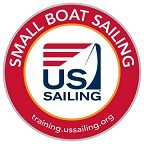
Many instructional programs teach on and rent small boats, including a majority of community sailing programs, most yacht club junior programs, and an assortment of aquatic centers, camps, parks & recreation departments, Y’s, Scout programs, university and military recreation facilities. By learning to sail a small boat with a US Sailing-certified instructor, you’ll learn the skills you need to build your confidence and ability to sail the boat well and safely.
The Learn Sailing Right! instructional books are the industry standard for small boat education, with step by step guidance for beginner and intermediate sailors. You may become a certified Smallboat Sailor by completing the requirements in the Little Red Book , US Sailing's Small Boat Sailor Certification Record Book, supplied and validated by your US Sailing instructor. Be sure to check out all of the US Sailing Education materials available for purchase in the US Sailing Store .
Find a Sailing Program Near You
The right sailing program for you might be just down the street! Browse our Where to Sail map for listings of sailing schools, yacht clubs, and community sailing centers near you.
Find a Sailing Program:
Where to Sail map
Windsurfing
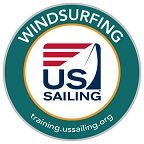
US Windsurfing partners with US Sailing to support recreational and competitive windsurfers across the country. For more information, visit: US windsurfing
Education, Youth
Risk strategies - gowrie group.
- Junior Sailing Safety Guide
- Responsibility to Your Students as a US Sailing Certified Instructor
- Advantages of US Powerboating’s Safe Powerboat Handling Courses
- Emergency Action Plans and Safety Resources
- Case Study: An Emergency Action Plan Report from OCSC
- The Importance of Accountable Sports Parents
- SafeSport Free Online Parent Training
- SafeSport Parent Tool Kits
- Winning the Race to the Right Finish Line in Youth Sports
- Can Youth Sports be Both Fun and Competitive?
- Developing Youth Sailors: What parents can do to build a strong foundation
- Hosting a US Sailing Championship
- Event Recap: Americans Finish On the Podium at RS Feva Worlds
- Youth Sailing: Get Out of Your Comfort Zone This Summer!
- Sailorships Financial Aid For Junior Sailors
- Ten Guidelines for Running the Junior Big Boat Program
- An Introduction to the Junior Big Boat Sailing Program
- Small Boat Sailing: Teaching Sportsmanship
- What Makes Classes Strong?
- Knowing Your Destination: Setting the Right Goals
- Top 10 Reasons to Sail a Catamaran
- Reviving Your Regional Youth Racing
- Introducing Adventure Sailing to Your Program

Whitney Kent Youth Programs Associate Email Whitney Kent
Zeth Morgan Education Coordinator Email Zeth Morgan

Bonnie Braddock Learning Design and Development Specialist Email Bonnie Braddock
Phil Muller Youth Performance Manager Email Phil Muller

Andrew Clouston SVP Programs & Services Email Andrew Clouston

Bradley Schoch Senior Instructional Designer Email Bradley Schoch

Peri Burns Educational Operations Manager Email Peri Burns 401-342-7963

Andi Barton Sr. Education Coordinator Email Andi Barton 401-342-7910

John Pearce Youth Racing Director Email John Pearce 401-342-7930
Copyright ©2018-2024 United States Sailing Association. All rights reserved. US Sailing is a 501(c)3 organization. Website designed & developed by Design Principles, Inc. -->
- Search Please fill out this field.
- Newsletters
- Water Sports
A Beginner's Guide to Sailing a Sailboat
Key Information for Beginners and Sailors
There are many ways to learn to sail:
- You can just jump in a boat with a friend and try to learn from experience
- You can sign up for a formal course at a sailing school
- You can buy or borrow a small sailboat and do it all on your own
No matter which way works best for you, it helps to understand the boat and what's involved in sailing first before you're out on the water, where suddenly you might get into trouble.
The Basic Steps of Sailing
Sailing involves both specific knowledge and skills. The following are the basic steps of learning to sail- as much as you can learn while not actually on a boat. You don't have to follow this order; skip ahead if you already know some of the basics. If you're mostly new to sailing, you might want to proceed through these steps like chapters in a manual.
- Understand Basic Sailing Terms. To get into sailing, you have to understand the words that are used to talk about the sailboat and the skills used to sail. Start here with a review of basic sailing terms. Don't worry about memorizing everything as many of these terms and concepts will become clearer as you read on about how to do it.
- Learn the Parts of the Boat. Before you go on the boat, it's helpful to know the words used in different parts of the boat. Even if you have an instructor, he or she won't say "Grab that rope over there and pull it," but instead will say "Haul in the jib sheet!" Review the basic boat terms you'll need to know.
- Start an Online Course. Now you're ready to learn more about what all those parts of the boat are used for. Here you can start an online learn-to-sail course by learning more about the parts of the boat along with a lot of photos, so you'll see what to do.
- Rig the Boat. Read to go sailing now? Hold it a minute- you have to rig the boat first by putting on sails and making other preparations. Here again are a lot of photos of what to do on a typical small sailboat used by beginners.
- Review Basic Sailing Techniques. OK, now you have the boat ready- so what do you do now to make it go? Manage the sails to go in the direction you want by learning basic sailing techniques.
- Discover How to Maneuver. Sailing in a set direction is reasonably easy, but eventually, you'll have to change direction. That often involves tacking and gybing. Take a moment to learn what's involved in these critical maneuvers.
- Recover From a Capsize. Now you've got the basics down. But did anyone ever tell you that small sailboats often tip over if the wind is gusting? Be prepared and carefully see how to recover from a capsize .
- Dock or Anchor the Boat. Now you're out there sailing and you've got the boat under control. Learn how to go faster, dock or anchor the boat and use some of the equipment you've ignored so far. Take a look at some of these additional sailing skills.
- Practice Tying Knots. For thousands of years, sailors have used times where it is cold or raining by doing things like tying knots. Knots are important on a sailboat and you will need to learn at least some basic sailing knots to sail at all.
- Sail Safely. At this point, plus practice on the water, you're good to go. However, it's good to remember that water is a dangerous place. Learn the basics about sailing safety. Staying safe makes it easier to keep having fun out there.
Related Articles
More related articles.
The Ultimate Guide to Small Boats: What Are Your Options?
Small boats offer a unique way to enjoy the water, whether you’re an angler, a day cruiser, or a weekend adventurer. They provide affordable entry points into boating while delivering versatile and personalized experiences. In this guide, we will explore different types of small boats, their key features, price ranges, and specs to help you decide which option best suits your needs.
Why Choose a Small Boat?
Small boats are ideal for those looking to get into boating without the commitment or expense of a large vessel. Some key advantages include:
- Affordability : Small boats generally cost less to buy and maintain.
- Ease of Use : Many are simple to operate, requiring minimal skill or certification.
- Maneuverability : Their smaller size makes them easier to navigate through tight spaces and shallow waters.
- Portability : Many small boats can be trailered or even carried by hand.
- Versatility : Suitable for a range of activities, from fishing to watersports.
Types of Small Boats
1. jon boats.
Jon boats are lightweight, flat-bottomed boats typically made from aluminum or polyethylene. They are favored by anglers and hunters because of their stability in calm waters like lakes and rivers.
- Specs : Range in length from 10 to 18 feet. Most models have a shallow draft, allowing you to navigate very shallow waters.
- Engine : Often powered by small outboard motors, though some are manually rowed.
- Capacity : Seats 2 to 4 people comfortably.
- Price : $700 to $5,000 depending on size and material.
- Easy to maneuver and transport
- Great for fishing in shallow waters
- Limited in rough waters
- Basic design without many features
2. Dinghies
Dinghies are small, open boats that can be powered by oars, small outboard motors, or sails. They’re commonly used as tenders to larger boats or for short-distance transportation in calm waters.
- Specs : Typically between 6 to 12 feet in length.
- Engine : Often powered by a small outboard engine (2-15 hp) or manually rowed.
- Capacity : Seats 2 to 6 people, depending on the size.
- Price : $500 to $2,000 for basic inflatable or hard-shell models.
- Versatile for various water activities
- Easy to transport (especially inflatable models)
- Often small enough to carry
- Not ideal for long-distance travel
- Vulnerable to capsizing in rough conditions
3. Inflatable Boats
Inflatable boats are constructed from durable rubberized fabric and are designed to be lightweight and easy to store when not in use. These boats are excellent for families or recreational boaters who need something compact and portable.
- Specs : 6 to 18 feet in length.
- Engine : Can be equipped with a small outboard motor or paddled manually.
- Capacity : Can carry anywhere from 2 to 8 people.
- Price : $200 to $5,000 depending on size, material, and brand.
- Extremely portable and easy to store
- Versatile for different activities
- Stable and buoyant
- Limited speed and power compared to rigid hull boats
- Requires inflation and deflation with every use
4. Kayaks and Canoes
These human-powered vessels are ideal for solo adventurers or small groups looking to explore lakes, rivers, and coastal areas. Kayaks are generally enclosed, while canoes are open-topped.
- Specs : Range from 8 to 17 feet for kayaks, and 12 to 20 feet for canoes.
- Engine : Paddled manually.
- Capacity : Kayaks are typically single or double-seaters; canoes can hold 2 to 4 people.
- Price : $300 to $2,500 depending on material and design.
- Perfect for exercise and exploration
- Low maintenance and affordable
- Suitable for quiet, peaceful waters
- Not ideal for open water or rough conditions
- Limited in speed and storage space
5. Jet Skis and Personal Watercraft (PWC)
Jet skis are small motorized vessels designed for high-speed thrills and are excellent for watersports enthusiasts. They offer a more adventurous experience compared to most small boats.
- Specs : Average length is 8 to 12 feet.
- Engine : Powered by an inboard jet drive with engine sizes ranging from 60 hp to over 300 hp.
- Capacity : Usually 1 to 3 riders.
- Price : $5,000 to $15,000 depending on the brand and engine power.
- Fun and fast; great for watersports
- Easy to tow on a trailer
- High maneuverability
- Limited storage space
- Not ideal for long trips or rough waters
6. Pontoon Boats (Small Models)
Pontoon boats are flat-decked boats that float on two or more aluminum tubes called pontoons. Smaller pontoon boats are great for families or groups who want a stable and comfortable ride on lakes or calm waters.
- Specs : Small models range from 12 to 20 feet.
- Engine : Outboard motors ranging from 25 hp to 90 hp.
- Capacity : Can comfortably accommodate 4 to 8 passengers.
- Price : $10,000 to $35,000 depending on size and features.
- Comfortable and spacious
- Great for family outings and relaxation
- Stable and safe
- Not suitable for rough waters
- Bulkier than other small boats
7. Center Console Boats (Small Models)
Center console boats are popular among anglers because of their 360-degree fishing capability and the central helm. Smaller versions provide versatility for both fishing and leisure.
- Specs : Typically 15 to 20 feet long.
- Engine : Outboard engines ranging from 60 hp to 150 hp.
- Capacity : Holds 4 to 6 people.
- Price : $15,000 to $40,000 depending on size and engine power.
- Excellent for fishing
- Good speed and power
- Limited in rough ocean conditions
- Not much shelter from the elements
How to Choose the Right Small Boat
When selecting a small boat , consider the following factors:
- Intended Use : Are you looking to fish, relax, or engage in watersports? Different boats serve different purposes.
- Water Type : Will you be boating in lakes, rivers, or the ocean? Choose a boat that’s designed for the conditions you’ll face.
- Budget : Small boats vary significantly in price. Determine how much you’re willing to spend, including maintenance, insurance, and storage costs.
- Storage and Transportation : Some boats can be easily trailered, while others may require a dock or mooring.
- Capacity : Consider how many people you’ll typically bring on board and make sure the boat can accommodate them safely.
Small boats offer a world of possibilities for boating enthusiasts, whether you’re after a leisurely cruise or a high-speed adventure. From affordable Jon boats to sporty jet skis, there’s an option for everyone. By understanding your needs and the specifications of each type, you can find the perfect small boat to get out on the water and enjoy the experience to the fullest.
Happy Boating!
Share The Ultimate Guide to Small Boats: What Are Your Options? with your friends and leave a comment below with your thoughts.
Read The Top 10 Winter Boating Destinations to Visit This Winter until we meet in the next article.
Similar Posts

Boating Shackles: A Comprehensive Guide
When it comes to boating, the importance of reliable hardware cannot be overstated. Among the various pieces of equipment, boating shackles are small yet essential components that play a critical role in ensuring safety and functionality on the water. Whether you’re securing rigging, connecting anchors, or fastening lines, shackles are indispensable in a wide array…
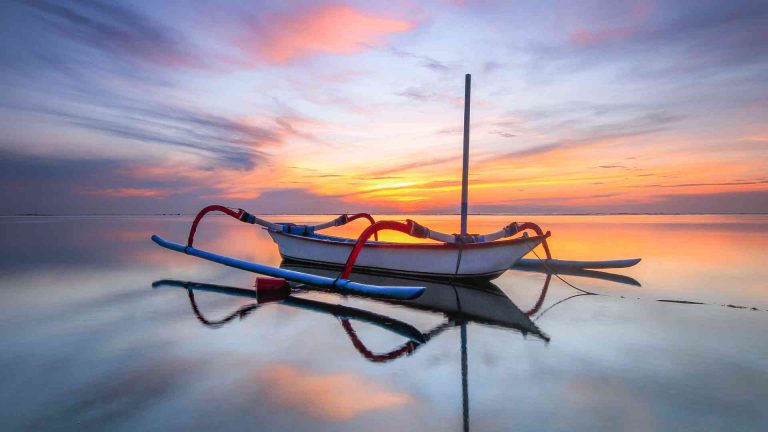
How Do Boats Float on Water: The Science Behind Buoyancy
The mesmerizing sight of boats gliding gracefully over the water has captivated human curiosity for centuries. The ability of these vessels to stay afloat, even while carrying considerable weight, has sparked wonder and intrigue. It is through the marvels of buoyancy that boats achieve this seemingly magical feat, and understanding this scientific principle unravels the…

A Look at 1960s Fiberglass Boats: Cruising Through History
The 1960s were a golden age for boating, and a major contributor to this boom was the innovation of fiberglass. Replacing traditional wooden boats, fiberglass offered a lighter, more affordable, and lower-maintenance alternative. This ushered in a new era of sleek designs, high performance, and a growing fascination with leisure boating. Let’s dive into the…

What’s the Back of a Boat Called: Stern Stuff
Ever hopped on a boat and gotten turned around? If you’ve ever been unsure whether to “head to the front” or “go to the back,” you’re not alone! Landlubbers and seasoned sailors alike can sometimes get confused about the proper terms for the front and back of a vessel. Well, fret no more, mateys! This…

Azimut Boats for Sale: Buying Guide
Azimut Yachts are synonymous with luxury, performance, and Italian design excellence. If you’re dreaming of cruising the seas in style and comfort, then an Azimut might be your perfect boating match. But before you set sail on your Azimut buying journey, here’s a comprehensive guide to equip you with all the essential knowledge. A Legacy…

6 Best Holiday Destinations for Boating: U.S. Edition
When it comes to holiday destinations for boating, the U.S. offers a stunning array of options, ranging from serene coastal towns to picturesque lakefront escapes. Whether you’re looking to cruise on calm waters, explore hidden coves, or partake in watersports, there’s a boating destination for every kind of traveler. In this guide, we’ll explore the…
$150 Off Captain's License Courses! Use code: CAP150
- Get Started
- OUPV/Six-Pack Captain’s License
- 25/50 or 100-Ton Master Captain’s License
- License Endorsements
- All USCG Captain's License Courses
- Mariners Crew
- Mariners Skipper
- Mariners Master Skipper of Power
- Mariners Master Skipper of Sail
- Mariners Master Skipper of Power & Sail
- All Recreational Courses
- FCC MROP – Marine Radio Operator Permit
- FCC Exam Package Deals
- FCC Individual Exams
- FCC Practice Test Books
- Captain's License Guides
- FCC License Guides
- Why Our Students Succeed
- MLS Learning Tools
- Online Testing
- American Hero Fund (ID.me)
- Licensing Guides
- How To Videos
- Help Center
- 24/7 Live Technical Support
- Mariners Life
- Mariners Gear
Add description, images, menus and links to your mega menu
A column with no settings can be used as a spacer
Link to your collections, sales and even external links
Add up to five columns
Essential Boating Safety Checklist: 13 Must-Have Items
September 17, 2024
When you’re out on the water, help could be far away. You don’t have time to wait during an emergency.
To stay safe and prevent accidents, you need the proper safety equipment onboard before you leave dock .
Not sure where to start? Use this boating safety checklist to ensure you have all the essentials for a safe trip.

Your Boating Safety Checklist: 13 Items
Most of the items on our boating safety checklist aren’t revolutionary in and of themselves, but we make sure to think through the details of each inclusion. Below, we’ll unpack not just the specifics of what you need, but why you need each item.

1. Life Jackets
The Coast Guard requires life jackets for every passenger to ensure the safety of everyone onboard a boat. To satisfy the requirement, most people will buy six adult jackets and call it a day. But they’re missing the most crucial part: proper fit.
If you have four adults and two children on your boat, six adult life jackets don’t fulfill the requirements. To keep your bases covered at all times, you can keep six child-sized life jackets on your boat in addition to six adult-sized ones.
2. Fire Extinguishers
Fire extinguishers protect you from potential fire hazards aboard your boat. To meet Coast Guard requirements, you not only need to have the right number of fire extinguishers, but you also need to have the right type kept in the right locations.
Where you keep your fire extinguishers depends on the configuration of your boat. For example, a single fire extinguisher meant to protect the entire boat shouldn’t be tucked away in the bow. If you have a galley fire, you may not make it to the front to get it.
I always recommend having more fire extinguishers than the minimum required. That way, you always have one within reach.
3. Sound-Producing Devices
A sound-producing device is helpful for signaling in situations with poor visibility, such as dense fog. Many mariners use air horns, but as you go through your boating safety checklist, be sure to double-check that your equipment still works. Some air horns lose their charge over time, and they may rust or decay.
4. Visual Distress Signals
If something goes wrong, you need a way to signal other boaters or shore. Visual distress signals such as flares and other devices get the attention of boaters around you in an emergency.
5. Emergency Position Indicating Radio Beacon (EPIRB) or Personal Locator Beacon
Personal locator beacons and EPIRBs send an emergency signal to the Coast Guard when triggered. This ensures that rescue can locate you quickly and accurately during an emergency.
EPIRBs need to be registered so the Coast Guard knows what boat set it off, who the owner is, and how to contact them. You can update the registration as necessary.
I once sold a boat with an EPIRB, and two years later the Coast Guard called to ask if I was okay. Luckily, the new owner had triggered the EPIRB accidentally, so the situation wasn’t urgent. If it had been a real emergency, failing to update the registration could have led to far worse results.
6. VHF Radio
Don’t fall into the common trap of relying on your phone to call for help. Instead, use a VHF radio for communicating with the Coast Guard and other vessels.
The Coast Guard isn’t monitoring your phone, and phones may be less reliable on the water. Plus, you may want to talk to other boaters when you come into dock or need assistance.
7. Navigation Tools
Up-to-date charts and other navigation tools ensure safe navigation in the area you boat. GPS is great, but electronics often fail. For safe boating, you also need a fixed, reliable compass onboard.
8. First Aid Kit
Any first aid kit is better than no first aid kit, but if you can, make sure yours is designed for marine emergencies. For example, it may have a fish hook remover or a treatment solution for marine bites and stings. A small box of bandages isn’t going to cut it!
9. Toolkit and Spare Parts
Parts break all the time, and having the bare necessities on board to fix common issues yourself is much better than floating around waiting for help. In addition to a basic tool kit, keep spare parts such as spark plugs and fuel filters with you.
10. Anchors and Lines
The Coast Guard doesn’t require an anchor, but I wouldn’t go anywhere without one. Without an anchor, you have no way of keeping your boat from drifting if something goes wrong. Make sure you have the right type of anchor for your boat and the bottom conditions where you operate.
11. Bilge Pump or Bailer
A bilge pump or bailer isn’t only important for leaks and holes. Dozens of situations could cause you to take on water, such as getting swamped by the wake of a passing boat. Having a way to remove water is essential.
12. Flashlight and Batteries
A powerful flashlight is crucial for nighttime visibility or just when dark clouds roll in. Look for a waterproof flashlight built for the marine environment, and stock plenty of spare batteries as well.
13. Sun Protection
Sun protection is often overlooked, but it’s one of the most important items for any good boating safety checklist. Besides long-term skin damage, spending too much time unprotected in the sun can lead to headaches, dizziness, and disorientation. You can prevent these issues by wearing sunscreen, sunglasses, protective clothing, and a hat.
Practice Carbon Monoxide (CO) Safety
More than 400 people die from carbon monoxide poisoning each year in the U.S., and more than 100,000 visit the emergency room. But not everyone knows that this odorless, colorless gas presents a real danger not just in homes, but on boats as well.
Practicing good CO safety is an important part of any boating safety checklist. To keep you and your passengers safe from carbon monoxide poisoning, follow these steps:
- Install CO Detectors: Use properly installed and well-maintained UL-approved marine CO detectors on your boat.
- Ensure Proper Ventilation: Keep enclosed spaces well-ventilated to avoid CO buildup; use fans and open windows or doors when feasible.
- Educate Passengers and Crew: Teach everyone on your boat the symptoms of CO poisoning (headache, dizziness, nausea, etc.) for quick identification and action.
- Check Exhaust Outlets: Make sure all boat exhaust outlets are clear before starting engines or generators.
- Be Cautious With Engine Use: Limit engine idling and be mindful of exhaust gas accumulation near the stern and swim platforms.
- Monitor Backdraft: Be alert to backdrafting when the boat moves slowly or idles, adjusting as necessary to reduce risk.
Safety Training for All Passengers
Safe boating is about much more than checking off all the items on your boating safety checklist. In fact, those items are useless if no one knows how to use them correctly. All passengers need basic safety training before coming onboard to ensure they’re aware of risks and how to avoid them.
The specifics of safety training depend on the type of boat, but in general, I focus my passenger training on three key areas:
- Preparedness: To make sure my passengers are ready for an emergency , I show them how to use the radio, emergency signals, and the GPS. This way, even if something happens to me as the captain, they can still get the help they need.
- Compliance: I go over everything from basic safety rules, like not drinking and driving, to more complex regulations, like requirements for safe boating courses.
- Communication: I recommend that all passengers understand how to communicate in an emergency — both for their safety and the safety of other boaters. I teach all my passengers the pro words MAYDAY, PAN-PAN, and SECURITÉ so they’re ready for any situation.
Boating is much safer when everyone takes emergencies and accident prevention seriously. The best way to stay ready for any situation is to go beyond the boating safety checklist and become an expert on safe boating practices.
With a recreational boating or captain’s license course, you can gain the in-depth boating knowledge that helps you stay safer on the water. Learn more about getting started with Mariners Learning System today.
Leave a comment
Comments will be approved before showing up.
Ready to Get Started?
Shop Courses or Talk to a Licensing Specialist

How To Sail a Small Sailboat

Sailing is a skill that takes time and practice to learn and perfect. Learning how to sail a small sailboat requires onshore and offshore activities.
Sailing heavily depends on the wind, and setting the sails right is a crucial sailing element. If you do not adjust the sails according to the wind, your boat will not move and, in worst cases, may even capsize.
Sailing is a skill that gets better with practice. There are several factors that you need to understand when sailing. These include the wind direction, how to turn and steer the boat, adjusting the sails, and finally, how to slow down and come to a stop.
Many novice sailors find handling the sailboat a daunting task. You have to take care of so many controls, including the tiller, the sails, and the centerboard.
Experienced sailors believe that new sailors should avoid taking their sailboats into open waters until they have gotten the hang of the water and the sailboat. Sailboats have tall sails, which make them prone to capsizing. Inexperienced sailors should either take courses on sailing or learn by going out with a friend before they head on their solo adventures.
Table of contents
How To Sail a Small Sailboat
Before heading out on your next boating adventure, you need to consider several factors. As the wind powers your boat, the first thing you need to understand is how wind strength and direction affect your boat. You will also need to learn how to handle the tiller. If you have been driving any road vehicle, you may not be surprised to see a vast difference between how a car and a boat handle.
Understanding Wind Direction
Wind plays a crucial role in how fast and the direction in which your sailboat will move. It is impossible to sail into a headwind. But you can sail around 45 degrees to headwind.
- When sailing 45 degrees to the oncoming wind, this is known in sailor jargon as the boat is close-hauled.
- When you are sailing with the wind coming from either side or almost 90 degrees to the boat, it is known for the boat to be on a beam reach.
- When you are sailing at a wide-angle in the direction of the wind. For instance, say that you need to head north, and the wind is coming from North East, the boat is called to be on a broad reach.
- If you are lucky and have the wind in the direction you are heading, your boat is known to be running.
Positioning Your Boat
It is crucial to be aware of the position of your sailboat in relation to the wind direction. This allows you to adjust the sails and balance the weight in your boat. For beginners, you can tie small wind vanes, which can be simple yarn strands on the boat to let you know where the wind is coming from.
What Affects Wind Direction
As you sail through the wind, your boat will also alter the wind direction. Since the boat has a giant sail, it creates its own wind as the boat moves forward. This wind is known as apparent wind. For instance, your boat is moving on a beam reach, where the true wind is coming from the side of the boat.
As you move through the wind, your boat makes its own apparent wind. The true and apparent winds combine, causing the wind direction to change. This can lead your boat to be on a close haul rather than on a beam reach. What matters, in the end, is how much resulting wind there is in your sails and the direction it is coming from.
Getting Ready To Sail
The best method to start sailing is to take the boat on from a point such as an anchor line or a mooring buoy. The wind will push the boat backward and out into the open waters as you get into the boat and set the sails up.
Moving stern first is acceptable when being pushed out of the marina, but this is not the direction in which we will want to continue sailing. You will have to turn the boat around so that wind is pushing the boat bow first.
Turning To Set Direction
As you come out of the marina, you will need to adjust your sails to change direction. Remember, boats require time to respond and need patience above all else.
The first step is to push the boom out of both sides of the boat. This will cause the wind to blow against the sail's back and not past its sides, causing the boat to rotate. As you pull in the sail and set its direction, the boat will begin to correct its course. Once you are in the right direction, you can tighten the mainsail and be well on your way.
Starting From A Beach Or A Dock
Starting from a beach or an enclosed dock can be quite challenging. If the wind pushes the boat sideways into the dock, it is next to impossible to sail out of the dock. In such a scenario, it would be best if you could walk your boat like a pet to the dock's end and attempt to turn it around to face the wind. You can then follow the procedure described above to allow the boat to come out of the marina.
Your boat will not move if the sails are not taut. As soon as you tighten the sails, the wind will move the boat, and you can then set the direction to your preference.
Steering The Boat
Now that you have set the direction and are moving in the correct direction, you will need to maintain direction and be able to steer the boat through the water. Before you begin to steer the sailboat, you must ensure that you are sitting in the direction opposite the sail. This is usually the direction from which the wind is blowing.
When the wind blows against the sails, it can cause your boat to tilt in their direction. Your body weight will counter the tilting effect and keep the boat level.
Using The Tiller
The sailboat is equipped with a rudder. As your boat picks up speed, you can use the rudder to steer the boat. A little tiller usually controls the rudder. The tiller takes some time to get used to. The reason for this is that it works in opposite directions. For instance, if you want to make the boat turn right (towards the starboard side), you will have to push the tiller to the left (towards the port side) and vice versa.
The rudder is hinged in line with the tiller. When you move the tiller in one direction, it moves the rudder. For instance, the rudder will extend towards the starboard side if you push the tiller to the port side. The water flowing will push against the rudder, and the resistance from the rudder will rotate the boat towards the starboard side .
The tiller can be tricky to use. Ensure that you make minor adjustments to the tiller until you get used to how it moves your boat.
Handling The Sails
There is one rule that you must remember when positioning your sails. If you are sailing towards the wind, you will have to pull in the sails more. Similarly, if you are on a broad reach and sailing in the direction of the wind, you will have to extend the sails more.
When the sails are extended and you are on a broad reach, you will notice that the boat tilts to the side the sails are on. You must seat yourself so that you counter the tilting effect.
Sail Trimming
No, you don't need a pair of scissors for this. A sail comprises multiple sheets, and adjusting these sheets is known as trimming the sail. Your goal with trimming the sail is to give the sail the best possible shape to make maximum use of the wind.
Mainsail Trimming
When trimming the mainsail, you will have to make sure that it is tight enough so that the sail's leading edge is not flapping or shaking. At the same time, you have to ensure that it is not too tight, causing the wind to blow against only one side of the sail. This can cause the boat to tilt to one side.
Leaving the edge loose means you will lose efficiency. The wind energy will be used to flap the sail instead of pushing your boat forward. This unwarranted movement of the sail is known as luffing, which can significantly reduce the boat's efficiency.
Adjusting The Mainsheet
One method to trim the mainsail is to let the mainsheet out until the mainsail starts to luff. Then slowly pull in the sheet, and stop as soon as the sail stops luffing.
If the sail is too tight, you will be able to judge by its appearance. The sail will have no slack and will look perfect. The only way to correct the tightness is to loosen it until it starts to luff, then tighten it gradually, and stop as soon as the luff is gone.
Trimming The Jib
Adjusting the jib also follows the same procedure as the sail. The goal is to loosen the sail until it starts to luff and then tighten it back up until there is no luffing. Like the mainsail, the appearance of the job will have a lot to say about its tightness.
Some sailboats have streamers on the leading edge of the jib, which depict airflow direction over it. When the sail is in the correct trim setting, the streamers will blow straight and on both sides around the sail.
Another factor to consider when adjusting the jib is the space between the mainsail and the jib. The gap, known as the slot, has to be the same from front and back. This ensures that wind flows smoothly between the sails, making the setup efficient. If either is too tight or loose, the slot will obstruct the wind flow, causing turbulence and slowing the boat down.
Turning The Boat
The most crucial part of sailing is always being aware of the wind direction. This becomes even more important when you are planning to turn the boat. If you are careless while making the turn and accidentally turn the wrong way, you may capsize the boat .
There are three common types of turns that you can make with sailboats.
Sailing Close Hauled
If the wind is coming at you head-on from either side, and you are close hauled, check for the direction of the wind. If it is blowing from the starboard side, turn the boat towards the right so that you point your bow into the wind. Continue turning until the wind is now coming to your port side. This technique is called tacking, which involves turning into the wind.
Sailing Broad Reach
If the wind is coming from either side or slightly behind you, you can turn so that the stern of your boat becomes head-on with the wind. For instance, if the wind is coming from the starboard side, you will turn left to make sure the wind hits the stern. This technique is known as jibing, and it allows you to make the turn downwind.
No Wind Crossing
This technique can be used if you want to make small turns. Say you are sailing close-hauled with wind flowing from your port side. You turn left, and now the wind is approaching from the side, and you begin to sail broad reach. The wind remains on your starboard side, but the direction has changed.
How To Position The Sails
For the initial two types of turns, where you will be crossing the wind with your stern or bow, the sails will have to be crossed over to the opposing side. You will also need to change your seating location to make sure you sit opposite the sails.
Since crossing the wind requires a lot of work, most sailors prefer to turn without crossing the wind. All you need to do is make small trimmings to the sail to keep you going in the right direction for this type of turn. With experience, you will be able to adjust the sails during your turn.
Remember, the closer the wind direction is to your bow, the more you will need to pull in the sails. The closer the wind direction is to your stern, the more you want your sails to be open. While turning, it would be best to keep one hand on the mainsail if you need to adjust its direction to prevent your boat from being blown in random directions.
The Centerboard
You will notice a thin and long blade of metal or fiberglass hanging from the boat's center and into the water. This component is called the centerboard, and it helps resist the sideways movement of the boat. You can raise or lower the centerboard at your discretion.
When you are sailing, the wind comes from either the left or right of the boat. If the wind is strong enough, it can push the boat to one side. Lowering the centerboard will cause it to act as a keel and prevent the boat from veering off in the wind direction.
When you are sailing along with the wind, you will have the wind coming from the rear of the boat, and it will have little influence from either side. In such a scenario, you will not need the centerboard. Raising the centerboard will reduce the drag, allowing you to sail faster.
As a beginner, it is recommended to keep the centerboard down. Who knows when it may save you? You don't have to be too concerned about it, as you have more important things such as the sail to worry about.
Slowing Down and Stopping
When it comes to sailing, speed is thrilling. Going fast is fun, but in a sailboat, speed is an achievement. The only thing more important than going fast is knowing how to slow down, such as when coming to a stop or avoiding an obstacle along the way.
Theoretically, to slow down, you have to do the opposite of what you would do if you wanted to speed up. This means that you will want to ensure that any wind that falls on your sails gets wasted or "spilled."
The best way to do this is to let out and loosen the sails until they begin to luff. If you need to slow down faster, you can loosen them further until they start to flap. If you plan to come to a stop, you can let the sails flap continuously.
However, if you are heading downwind or running, the mainsail should not be pushed out. Instead, you can pull it in as much as possible so the sail will not collect any wind. With no wind in the sails, your boat will slow down.
The simplest way to stop the boat is to turn it towards the wind. This will ensure maximum resistance and bring the boat to a halt.
Related Articles
What Are Small Sailboats Called?
10 Best Small Sailboats (Under 20 Feet)
Are Small Sailboats or Big Sailboats Faster?
Jacob Collier
Born into a family of sailing enthusiasts, words like “ballast” and “jibing” were often a part of dinner conversations. These days Jacob sails a Hallberg-Rassy 44, having covered almost 6000 NM. While he’s made several voyages, his favorite one is the trip from California to Hawaii as it was his first fully independent voyage.
by this author
How to Sail
Most Recent

What Does "Sailing By The Lee" Mean?
Daniel Wade
October 3, 2023

The Best Sailing Schools And Programs: Reviews & Ratings
September 26, 2023
Important Legal Info
Lifeofsailing.com is a participant in the Amazon Services LLC Associates Program, an affiliate advertising program designed to provide a means for sites to earn advertising fees by advertising and linking to Amazon. This site also participates in other affiliate programs and is compensated for referring traffic and business to these companies.
Similar Posts

How To Choose The Right Sailing Instructor
August 16, 2023

How To Sail From California To Tahiti
July 4, 2023

How To Tow A Skier Behind A Boat
May 24, 2023
Popular Posts

Best Liveaboard Catamaran Sailboats
December 28, 2023

Can a Novice Sail Around the World?
Elizabeth O'Malley
June 15, 2022

4 Best Electric Outboard Motors

How Long Did It Take The Vikings To Sail To England?

10 Best Sailboat Brands (And Why)
December 20, 2023

7 Best Places To Liveaboard A Sailboat
Get the best sailing content.
Top Rated Posts
© 2024 Life of Sailing Email: [email protected] Address: 11816 Inwood Rd #3024 Dallas, TX 75244 Disclaimer Privacy Policy

IMAGES
VIDEO
COMMENTS
Its enduring popularity, strong class association, and supportive community make it a beloved classic in the world of small sailboats, embodying a perfect blend of performance, comfort, and inclusivity for sailors of all levels. 8. Hobie Cat. Start a fun hobby with the Hobbie Cat. Length: 16.7ft / 5.04 m.
You can learn to sail on any sailboat but small boats are better teachers because they react quickly to crew weight shifts, wind shifts and every command on the tiller or wheel. This immediate feedback is a valuable tool for student sailors and it's usually easy to spot sailors who started out on smaller tiller-driven boats rather than on large steering wheel boats because they're more ...
Sailing is a fun activity for people of all experience levels. In fact, learning to sail a basic boat is relatively easy—in the right environment, you can start cruising with minimal experience. However, the idea of a beginner commanding a 55-foot ketch in the middle of the Atlantic Ocean is a bit ridiculous.
A small and lightweight boat can get you in trouble in gusts. Look for a stable craft with a low center of gravity that forgives mistakes. Small catamarans like Hobie cats or the inflatable MiniCat or wide, flat-bottomed boat should help. Simple. When learning to sail, focus on the basics of sail trim and shape. The boat needs just a few ...
New dinghy sailboats can range from $3,000 to $10,000, depending on the model and features. These small, lightweight boats are relatively inexpensive to maintain and store, making them an economical option for beginners. Keelboats, such as the Catalina 22 or Hunter 23, can cost between $5,000 and $20,000 for a used boat in decent condition.
Catalina 16.5. jlodrummer. Catalina Yachts are synonymous with bigger boats but they have some great and smaller boats too such as Catalina 16.5. This is one of the best small sailboats that are ideal for family outings given that it has a big and roomy cockpit, as well as a large storage locker.
Here are my top three picks of best small sailboat for beginners: Sunfish. Hunter 15. Catalina 16.5. If I had to pick one, I would go for Hunter 15 sailboat because it has the the best safety features. The Hunter 15 sailboat is also easy to operate, plus you can dock with no problem. The boat is easy to maintain, and it's not complicated for ...
The Best Sailboats Under 25 Feet. Pocket cruiser: Cornish Crabber 24. British manufacturer Cornish Crabber has been producing beautiful, traditional style small sailboats for decades, ensuring they honor their heritage both in the construction style and appearance of their boats. The Cornish Crabber 24 is the most iconic of their range and ...
Skipper craft SC-200: This sailboat is very small, quite old, and very affordable. It is a simple boat that is perfect for learning. Should you damage this boat you aren't likely to completely scupper it and the repairs will be cheap. You can pick one up for as little as $2k.
Catalina 22. If you're looking for the minivan of small sailboats—functional, family-friendly, and reliable—the Catalina 22 is for you. Ideal for weekend trips with the family, this boat offers a cabin for shelter, a cooking space, and even a small toilet. It's a floating home away from home.
Types of Small Sailboats and Their Unique Features. The world of small sailboats is rich and varied, encompassing a range of designs each suited to different sailing needs. Dinghies, for instance, are the perfect starting point for those new to sailing. Their simplicity and small size make them ideal for learning basic sailing skills.
It's a small sailboat with a cabin that's easy to handle and can be trailered. It weighs 1,200 pounds. 3. Com-Pac 23 is a larger sailboat that's still easy to handle. A great option for beginners seeking comfort is the Com-Pac 23. You can get it for $20,000-$30,000. This sailboat offers a cozy cabin and ample storage for your sailing adventures.
No roundup of best small sailboats (trailerable and fun too) would be complete without a mention of the venerable Hobie 16, which made its debut in Southern California way back in 1969. ... The Venture's designed to be both a good performer under sail, but also stable, making it a good boat for those learning the sport. $14,900, 203-259-7808 ...
The International Optimist Dinghy, a youth learn-to-sail and racing boat . Small catamarans Multi-hulls are renowned for their stability and therefore make excellent first sailboats. But size is a big factor and 'small' is the keyword here. Catamarans are fast and easy to maneuver, and the trampoline between the hulls makes for a fun ...
They also make you appreciate the boats in new ways when on a trip or with traveling companions. West Wight Potters are small cruising keelboats that are great for beginners. They are an excellent choice for a small keelboat for learning to sail and towing around. These sailboats are available in 15 and 19 feet lengths.
1984 • 8.3 m. Embed. John Vigor turns the spotlight on twenty seaworthy sailboats that are at home on the ocean in all weather. These are old fiberglass boats, mostly of traditional design and strong construction. All are small, from 20 feet to 32 feet overall, but all have crossed oceans, and all are cheap.
Small boat sailing is a simple, inexpensive way to get started in the sport. The fundamental basics of sailing are most easily learned in small boats. Many small boats are designed specifically for youth, and most provide a lifetime of enjoyment for adults as well. Generally, small boats, are under 25 feet in length.
However, learning the basics of sailing on this boat can be a bit more challenging than a Laser or a Sunfish. Challenger Trimaran. ... This is one of the most stable small boats you can buy, so if a lot of capsizing as you learn to sail doesn't sound appealing to you, it may be a good option for your first sailboat. ...
1. Twelve of the best training boats Sailing schools, clubs and training centers use a variety of boats with beginners, including singlehanders such as the Pico, Hartley 10 and the RS Quba, the latter having three rigs catering from entry level to more experienced sailors. There's also a range of larger training dinghies from builders such as RS, Topper, Laser and Hartley Boats.
In most small sailboats, the jib sheets are left tied to the sail's clew and stay with the sail. On your boat, however, the jibsheets may remain on the boat and need to be tied or shackled to the clew at this stage. Unless there is a shackle on the sheets, use a bowline to tie each to the clew. Then run each sheet back past the mast to the ...
Practice Tying Knots. For thousands of years, sailors have used times where it is cold or raining by doing things like tying knots. Knots are important on a sailboat and you will need to learn at least some basic sailing knots to sail at all. Sail Safely. At this point, plus practice on the water, you're good to go.
The best budget small cruiser sailboats include the Catalina 22 for its versatility, Hunter 27 for durability, Beneteau First 20 for performance, West Wight Potter 19 for compactness, Compac Sun Cat for ease of use, MacGregor 26 for adaptability, and Jeanneau Sun Odyssey 349 for comfort and style. As a seasoned sailor with years of navigating ...
Types of Small Boats 1. Jon Boats. Jon boats are lightweight, flat-bottomed boats typically made from aluminum or polyethylene. They are favored by anglers and hunters because of their stability in calm waters like lakes and rivers. Specs: Range in length from 10 to 18 feet. Most models have a shallow draft, allowing you to navigate very ...
If you have four adults and two children on your boat, six adult life jackets don't fulfill the requirements. To keep your bases covered at all times, you can keep six child-sized life jackets on your boat in addition to six adult-sized ones. 2. Fire Extinguishers. Fire extinguishers protect you from potential fire hazards aboard your boat.
Frontex, the EU's border force, has calculated a 64% drop this year in those making the crossing from North Africa to Italy. Central to the fall in crossings to Italy are financial deals struck ...
Learning how to sail a small sailboat requires onshore and offshore activities. Sailing heavily depends on the wind, and setting the sails right is a crucial sailing element. If you do not adjust the sails according to the wind, your boat will not move and, in worst cases, may even capsize.
EASY TUTORIAL!Learn how to build the easiest AFK farm in Build A Boat For Treasure without using any tools! This beginner-friendly method will help you earn ...
Prime Minister Sir Keir Starmer has said he is "interested" in learning about Italy's scheme to send migrants rescued at sea to Albania to process their asylum claims, as he begins his first ...
1. Twelve of the best training boats Sailing schools, clubs and training centres use a variety of boats with beginners, including singlehanders such as the Pico, Hartley 10 and the RS Quba, the latter having three rigs catering from entry level to more experienced sailors. There's also a range of larger training dinghies from builders such as RS, Topper, Laser and Hartley Boats.
Sept. 15 (UPI) --Eight migrants attempting to cross the English Channel from France in a small rubber boat died early Sunday, officials said.The vessel with around 60 people from countries ...